Old 2D & 3D Image Gallery
This page (which may take a bit to load) contains some of my old original 3D artwork as well as some grabs of early 2D work I did in BASIC, and C programming. The early BASIC stuff is as early as 1987 or so. Most of the DOS images are grabbed on my Mac using DOSBox emulator which I can use to still run many of these programs I wrote. The 3D work ranges a year or so after I started in 3D circa 1990, to a little later when I had a few years under my belt, but still before I ever got my first job. Generally from 1990-1995 or so is what is here.
This may be interesting if you are trying to get into the industry, as you can compare my current work, to some of this really old stuff, and perhaps that to what you yourself are doing now. It's also fun to look at older limitations of graphics. For example early PC days had just CGA with 4 Colors, then EGA with 16 colors and then VGA with 256 colors and 320x240 resolution.
A lot of it was created on an Amiga 3000 with Impulse's Imagine 3D software. At that time I think I had a 100 meg IDE drive, with 18 megs of Ram (16 basic, 2 video) and mostly worked at 320x240 with 4096 colors. Later I bought a Firecracker24 board, and worked at higher res's like 1024x768 with True 24 bit color for still images. Only 4096 color may not seem like a lot but it was a lot higher than PC's of the day which did 8-bit 256 colors. The latter was my primary computer for programming and school work. I wrote myself 8-bit paint program in C during High School and College which you can see images of below.
In addition to the Amiga 3000 my father also had a full Video Toaster setup with the first versions of Lightwave 3D. I dabbled with that as well using his double S-VHS deck setup to do some single frame recording for full video res 24 bit images into video animation. There's a shot of me in our family room circa 1990 or so with this setup halfway down this page.
I used Imagine from version 1.0 all the way through 3.1 or so, when I had switched over to the PC version of the software, and off of my Amiga. Shortly after that, I started using Lightwave 3D 4 when it came out for the PC. This is about the time of the Seaquest DSV shows, and Babylon 5. A lot of the stuff from that inspired me. I pretty much used Lightwave 4 for a while, and then eventually got a job at Volition using 3D Studio Max 3.1.
See my About Me Page for more info on how I got started in the industry and involved in CG.
Note that some of these images are digital photos based off of old printouts I had, so the quailty/color depth is kind of poor and are noisy. Others are captures off of SVHS video reels I had made while others are actual original digital renders. So quality will vary. In a few cases I include lowres MPEG4 videos embeded just for fun and reference. I have many old reels including an hour or more of "old original footage" of mine that wasn't so much a reel as it was just a video of all of my old work. Let me know if interested perhaps I will put some of these on youTube.
So without further ado, here is the "artwork"...
Early BASIC Programming and Graphics
BASIC CGA Lines That's right! We can draw lines in 4 colors yo!
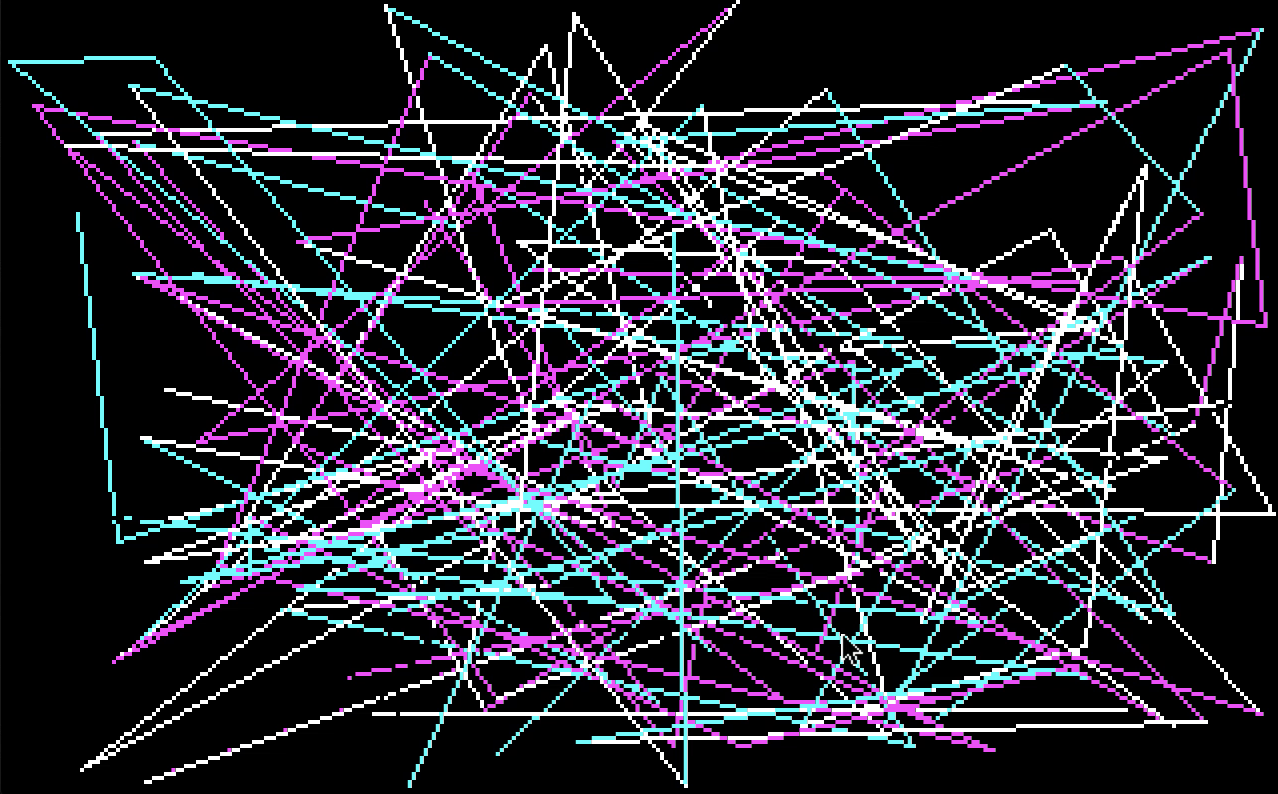
BASIC Design Lines Screen grab from a BASIC programming language program that allowed the user to pick a number of
points, a number of connecting lines and then randomly drew colored lines.
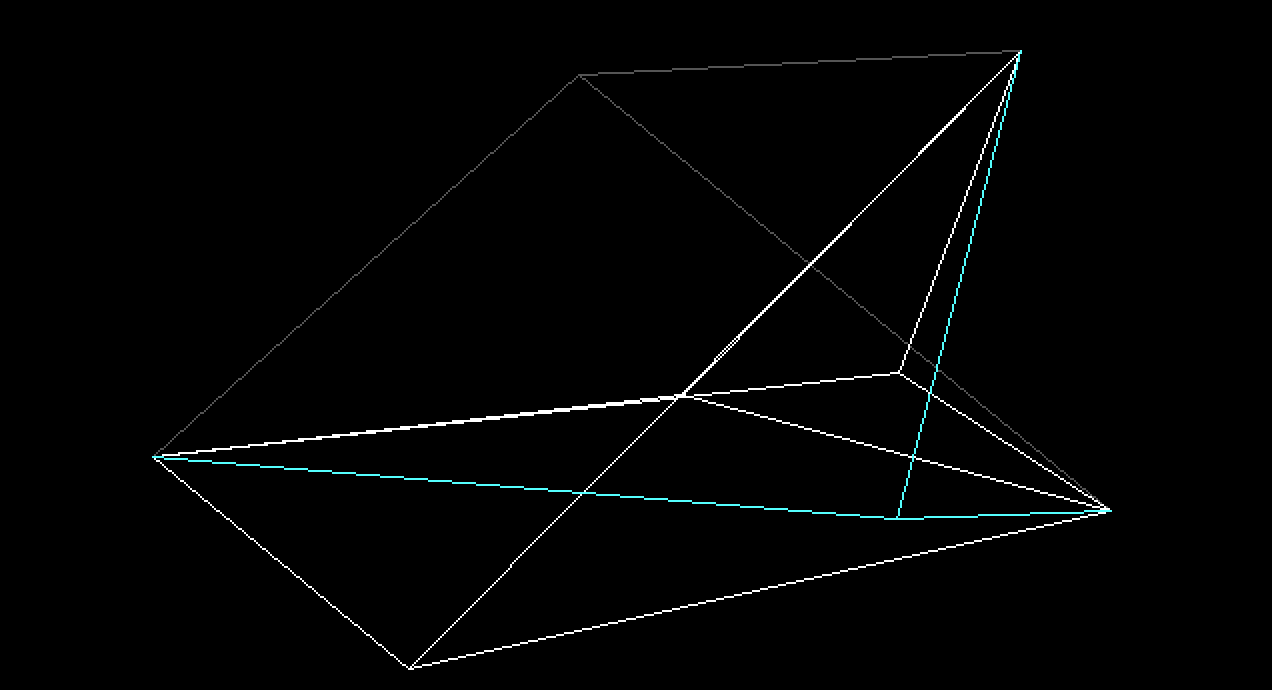
BASIC Graph Program I believe I either wrote out or hacked an existing graphing program in BASIC. If I recall I
used this for some of my High School science class work to help me out.
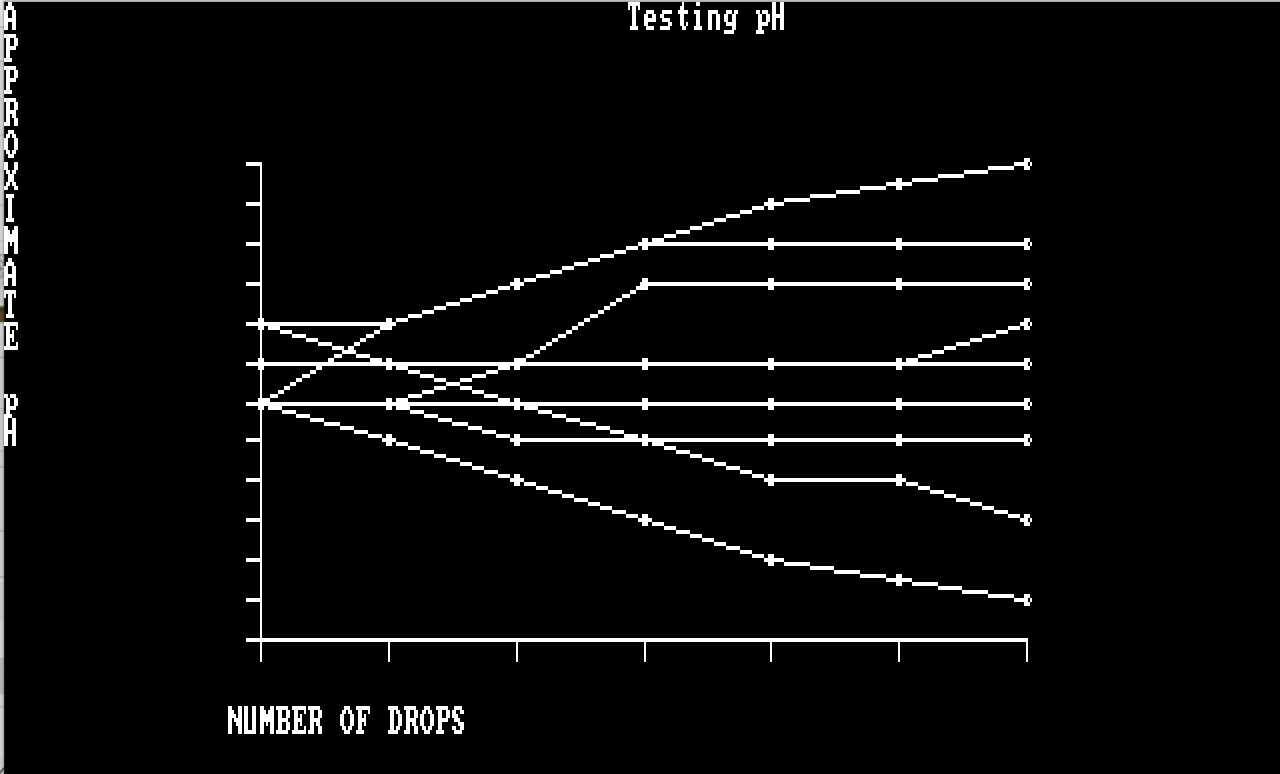
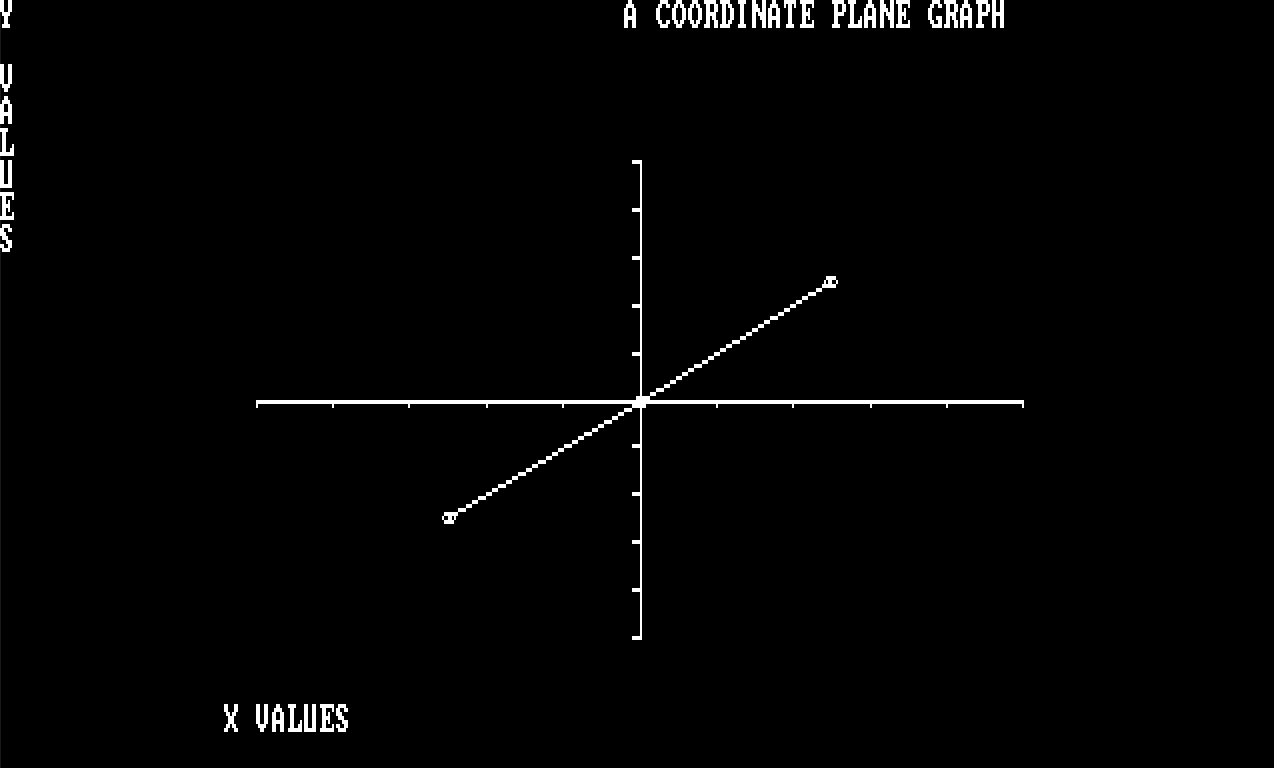
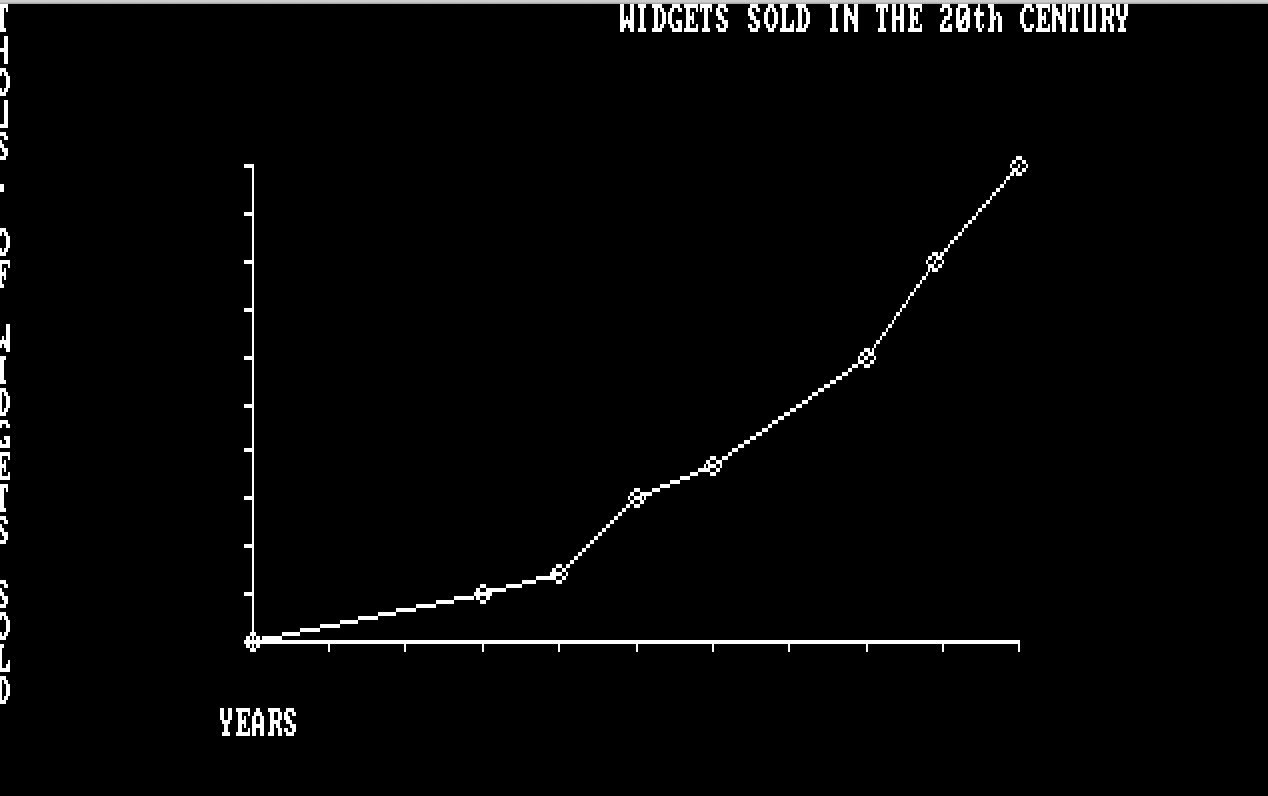


BASIC Early Programming Me on the right holdinga 5.25" floppy and one of my younger brothers on the left. This
was a photo taken of a photo so I had to clean up some of the reflections. This looks to be a very early 80's photo of
me. As a note that is a book on sharks on the bottom left corner.

BASIC Asset Title Title Screen from an Asset program I wrote.
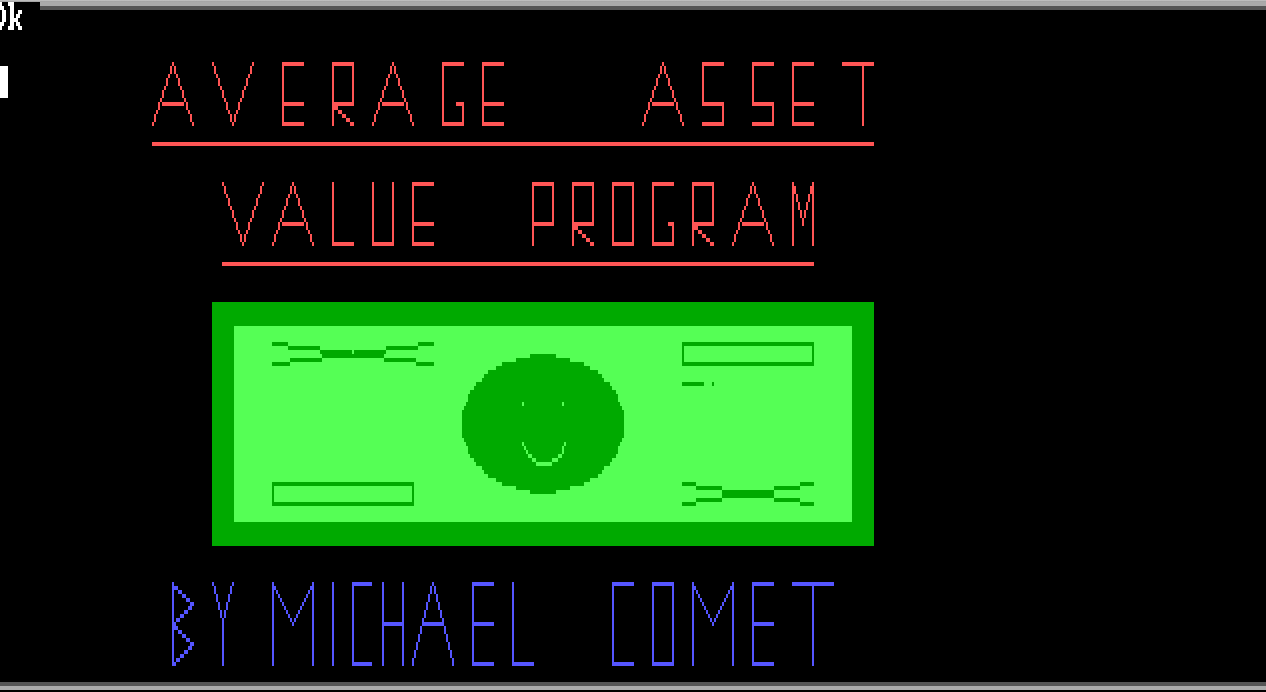
BASIC Morse Code Title Screen Title Screen from a Morse Code program I wrote to help me learn for my HAM radio
license.
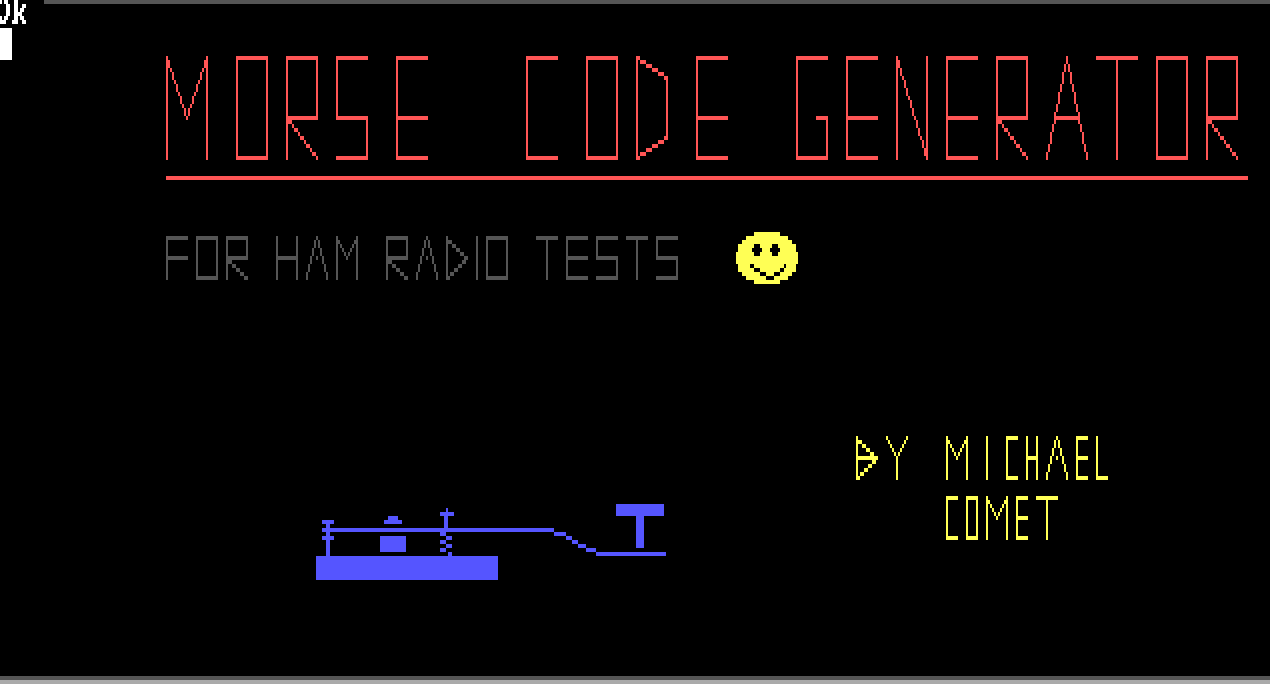
BASIC Dungeons & Dragons Title Screen I wrote an program in BASIC to help do things like store player data,
monster data, do virtual dice rolling etc. Never really used it but it worked for basic items. This was the title screen.
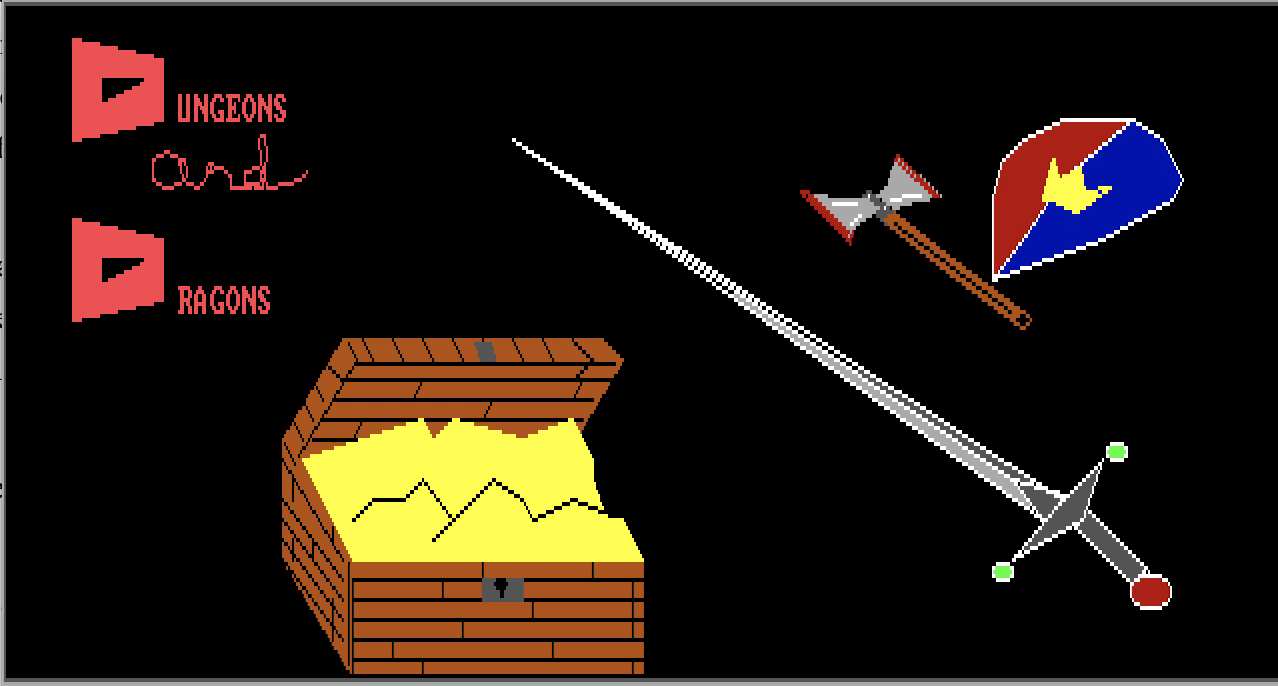
BASIC Top Gun Game I tried writing a simple Top Gun flying game - because TOP GUN !!!! Awesomeness. Didn't really
quite work too well. During the opening screen the theme song plays one note at a time on the computer speaker. Amazing!
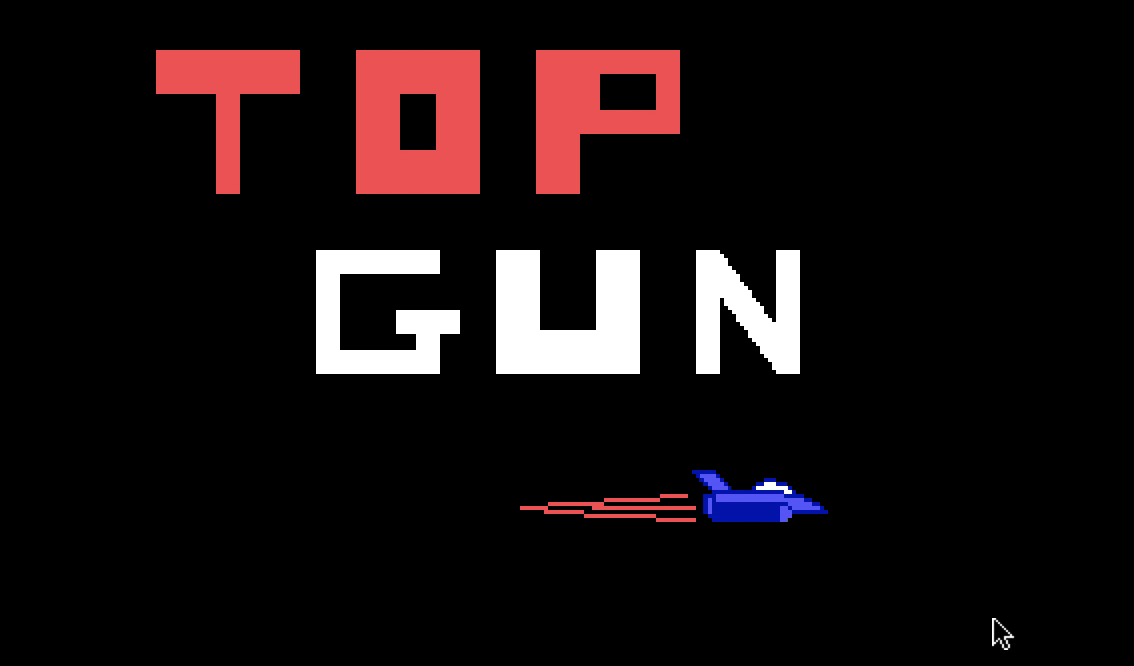
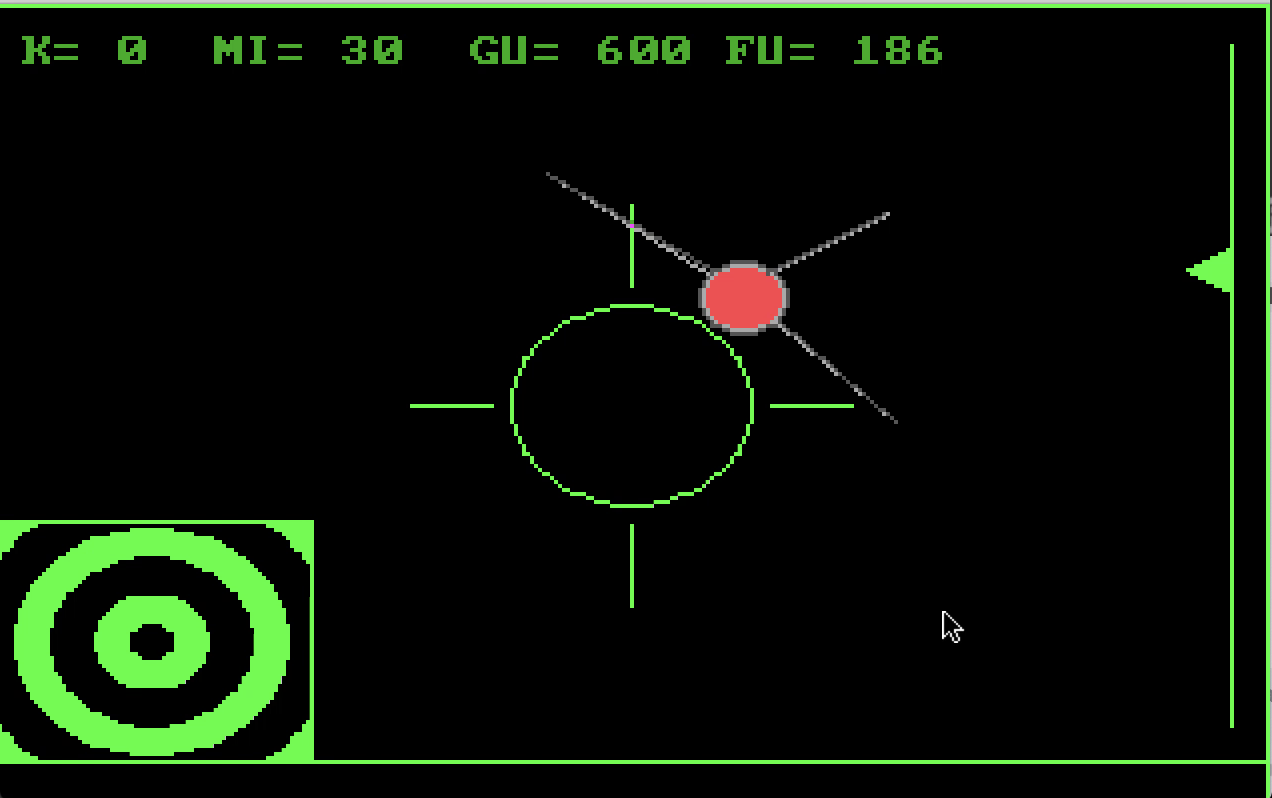
BASIC War Games Sticking with movie themes I also tried to write a War Games emulator similar to that in the movie.
This obviously was pretty basic and I couldn't do speech synthesis. It did however have a preset opening where you had to
enter JOSHUA as the password and then typed back and forth to start the game. Beyond that it was just text and some simple
computer speaker sounds.
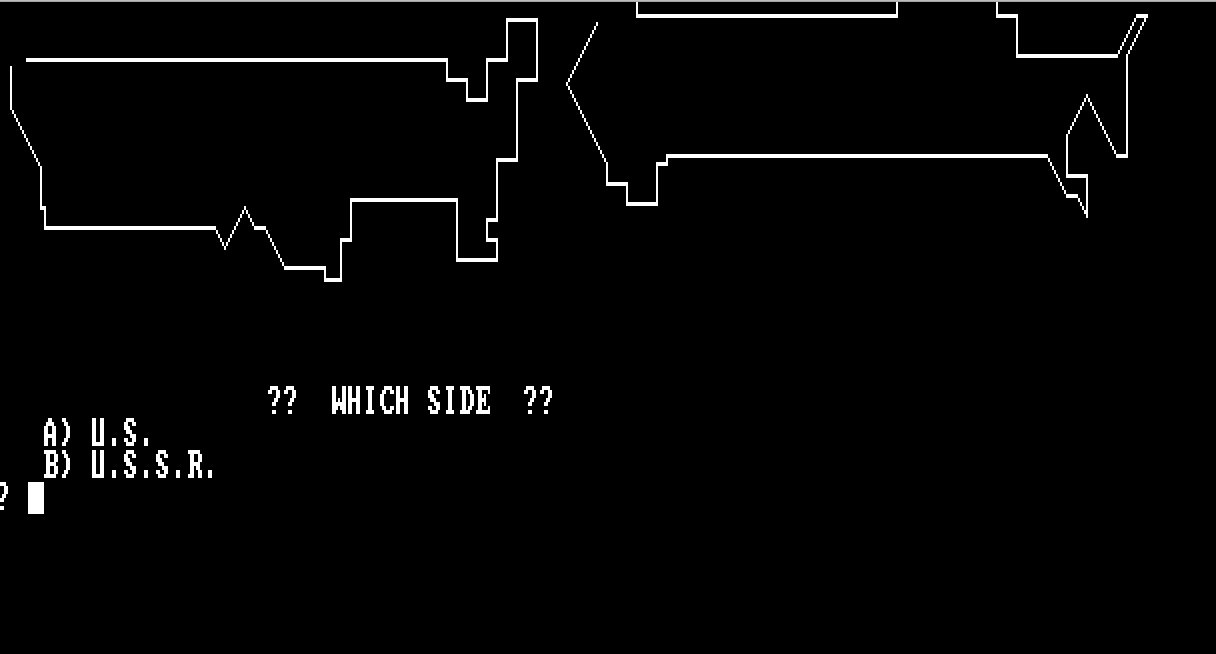
BASIC Coding and me 1990 Me with a High School cross country shirt so likely 1989 or 1990 at our old PC where I
did all my early programming. Note the famous cutaway countach poster in the second picture, signed and numbered and now
in my family room.
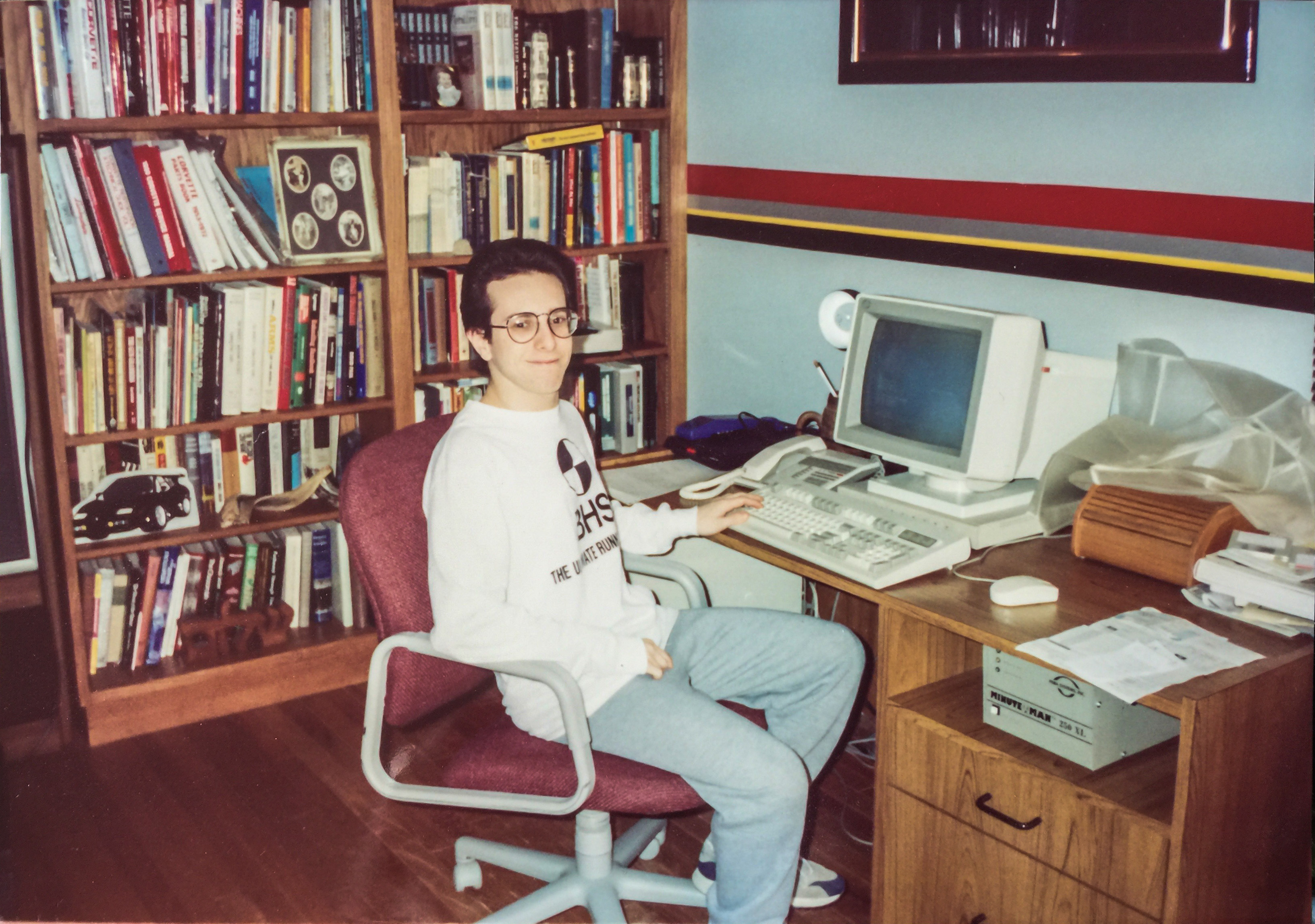

BASIC Computer Aided Animation Program Since I started doing a lot of programs in BASIC with graphics I ended
up writing a program to help me out I named CAAP. This took basic draw commands that I could enter with a keyboard vs. coding
and saved them out to a file that could then be read back in to recreate the images. I used this to generate a number of
pictures including some for title screens and such of other programs. Shown here is an earlier version of the Title Screen
as well as a sample of a few basic things it could do.
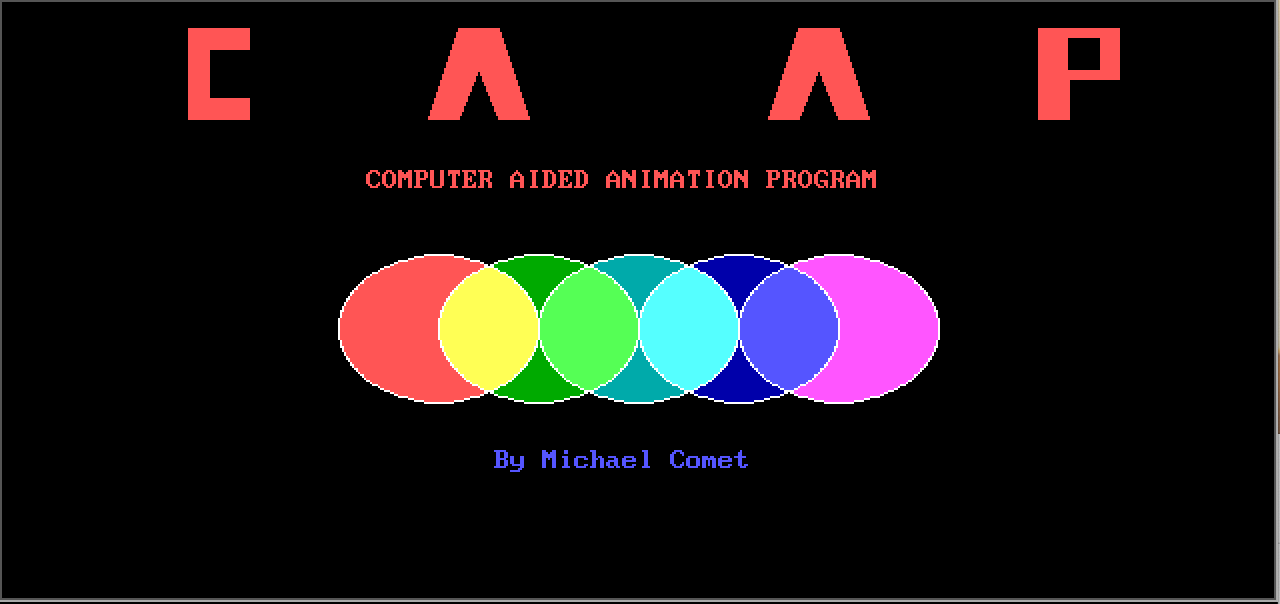
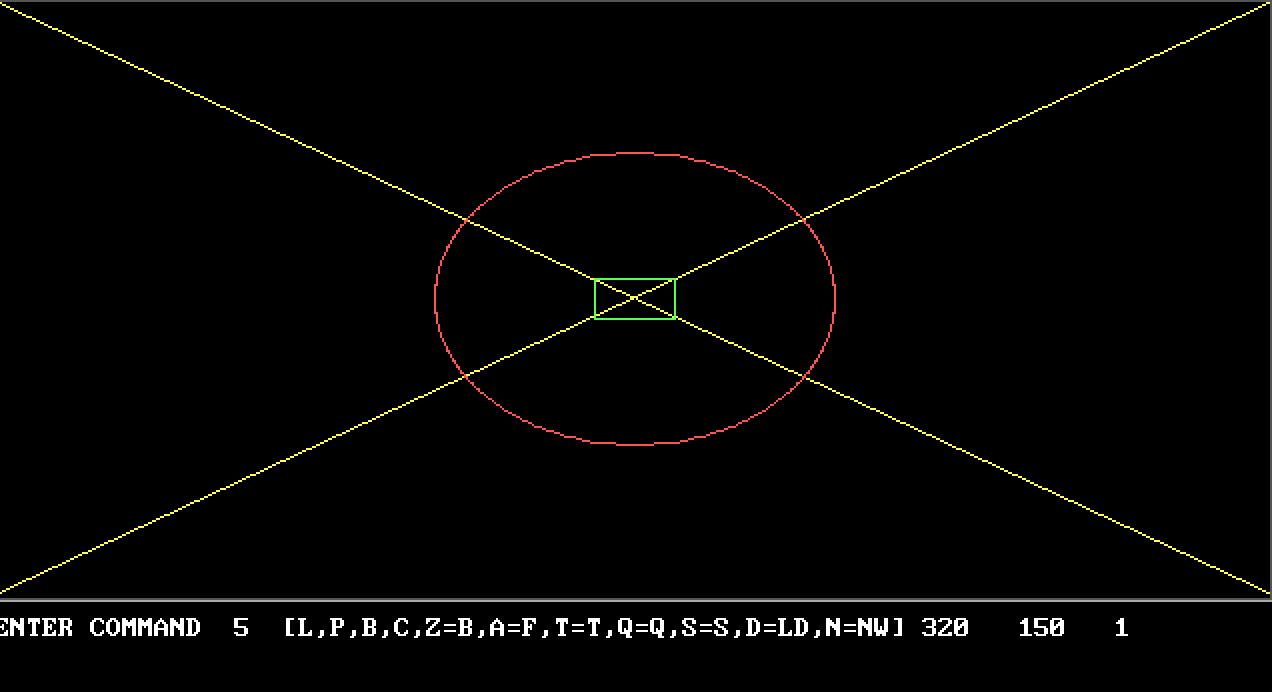
BASIC Skeleton Head with CAAP Skeleton head pictures and program made with the CAAP program above.
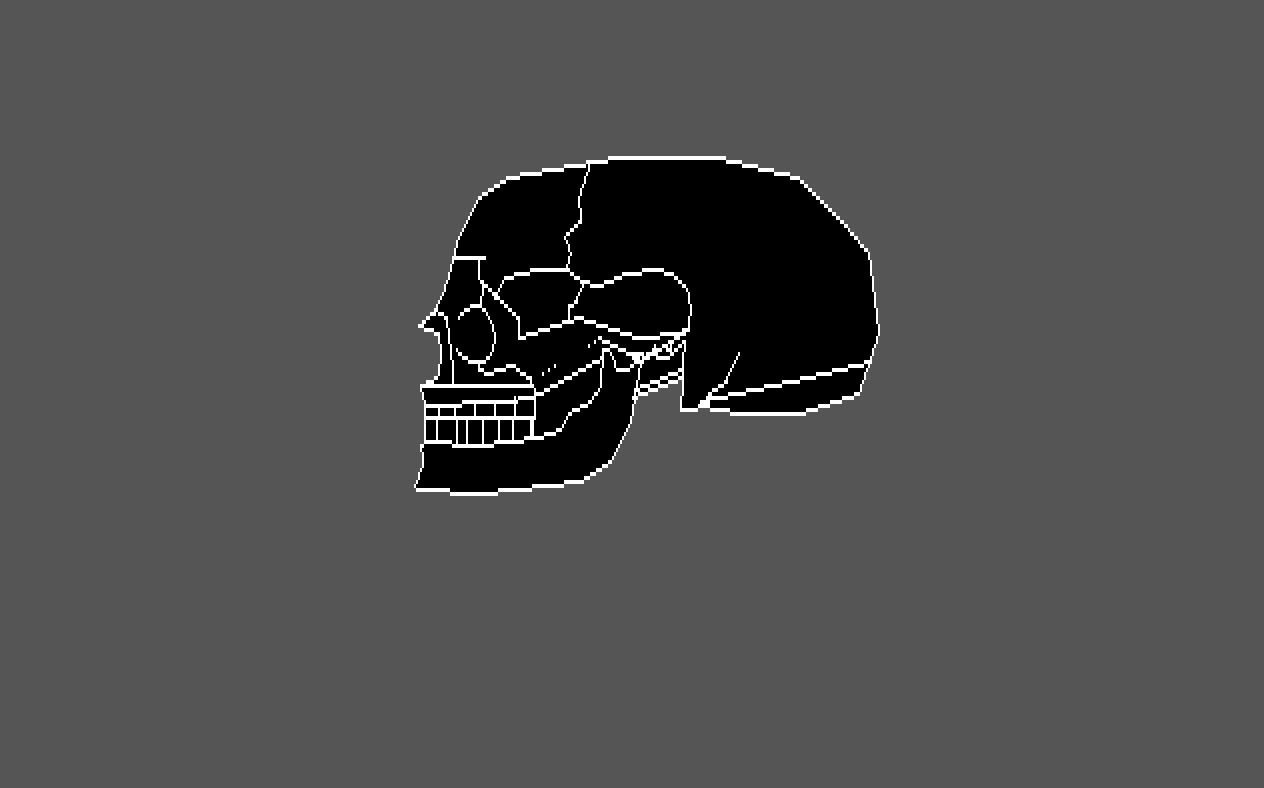

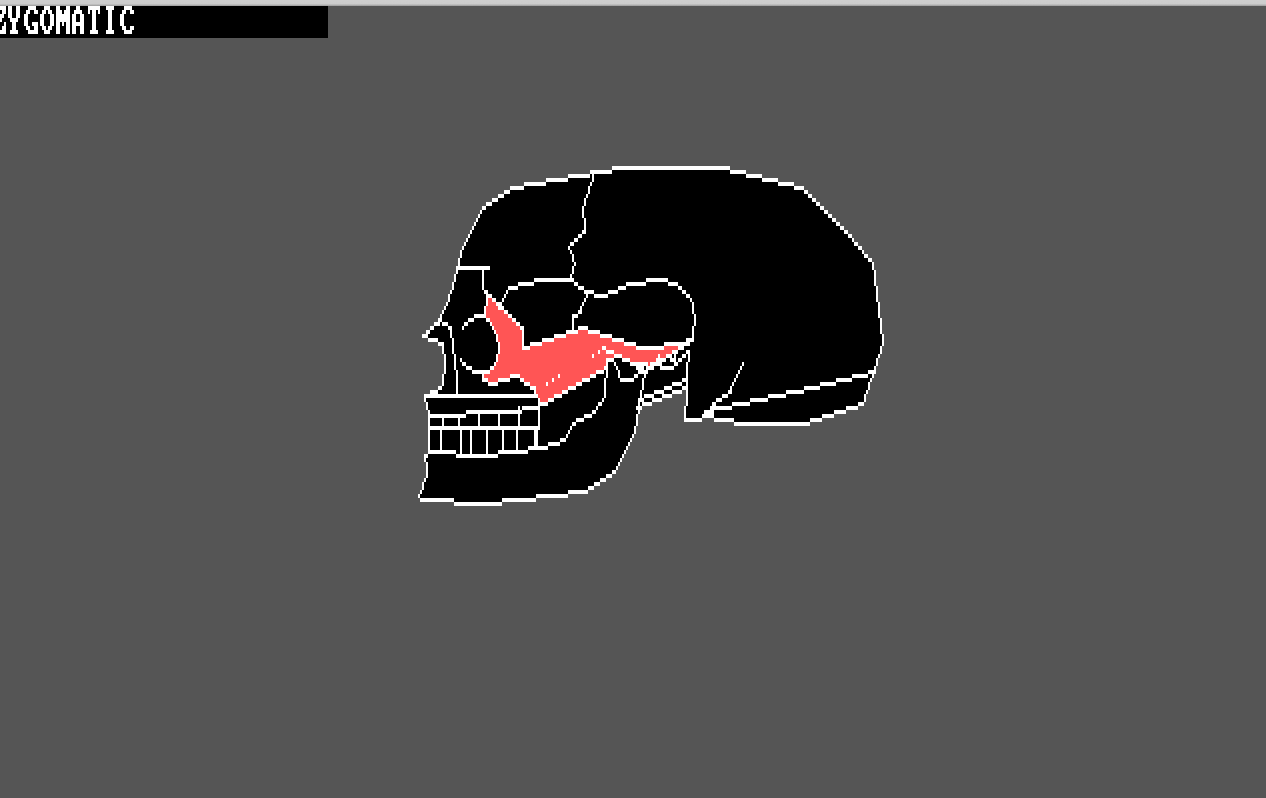
BASIC Atari Lynx with CAAP My first handheld game system and the first ever color handheld game system made was
the Atari Lynx. I recreated it here using the CAAP program. I still have my actual original Atari Lynx, games, and box
from the 80s. I have a BASIC program that used this outer graphics and animated the inside sky, grass and jet to mimick
playing the "Blue Lighting" game on the Lynx. Being that the Lynx came out around 1989 this is probably from around then.
I include a few shots of my actual Atari Lynx system here too.
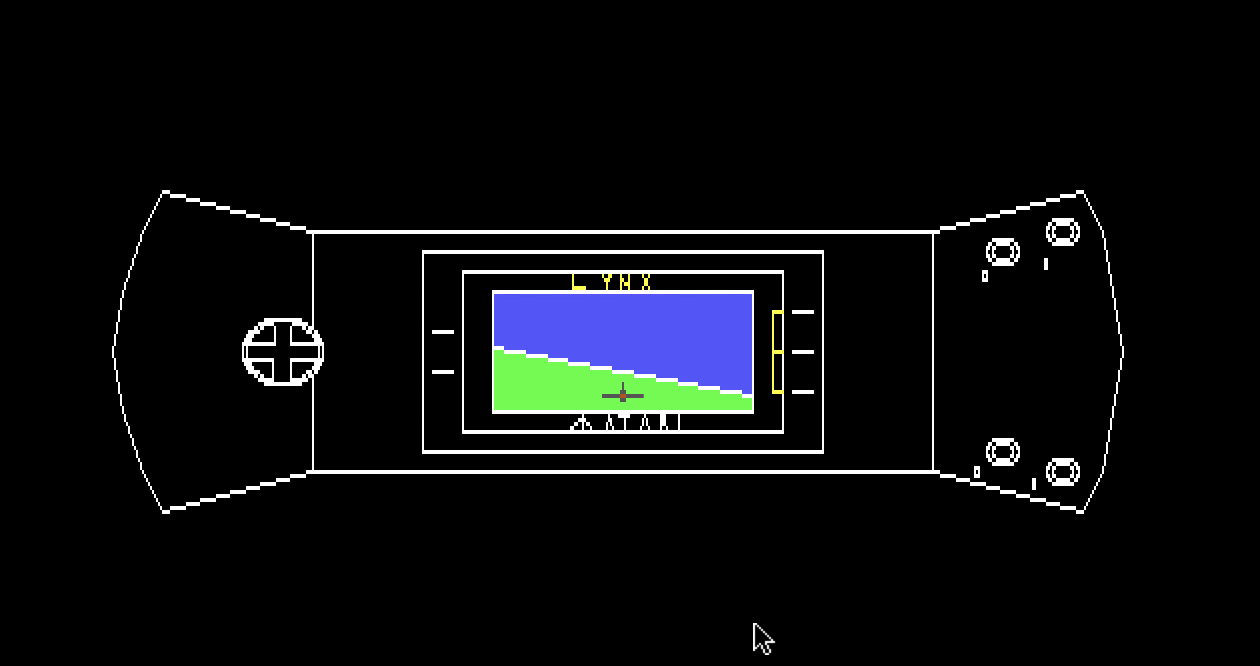

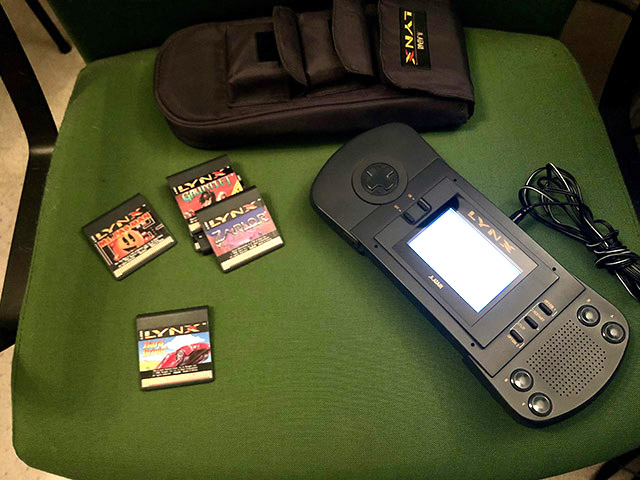
BASIC Ensoniq Performance Sampler In addition to the computer programming I also made my own music. This included
connecting my Ensoniq Performance Sampler (EPS) up to the computer via MIDI and grabbing and encoding that to play back as
well. My early computer music was just computer speaker tones. By the time the first Sound Blaster came out I was able
to connect my sampler, provide MIDI data and then put that into my programs. I have videos I will put on my YouTube
channel with some of this as well. For fun I decided to "draw" my keyboard using my Computer Aided Animation Program I
wrote. That picture is below as well as a screengrab from the internet of what the real keyboard looked like.
For Fun I also include some photos from me in January 1989 with a smaller earlier keyboard or two. One I believe was a
cheap Casio SK-1 Sampler Keyboard. I also had a Mattel Synsonics Drums pad circa 1981 or so in the right side storage
unit below another keyboard and reverb unit. You will also notice my stereo and tape deck set on the top left.
Finally you may also notice the white Lamborghini Countach poster on the top left in the first image. I still
have this original poster and frame and it now hangs in my office at work.
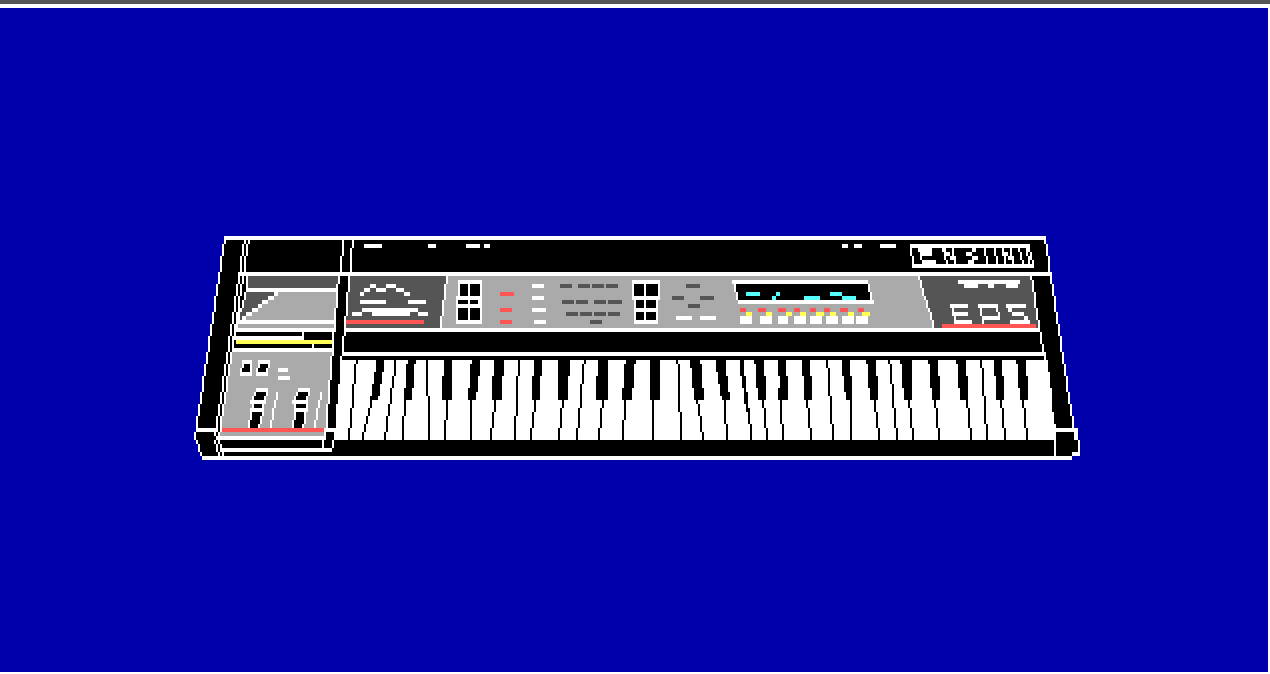


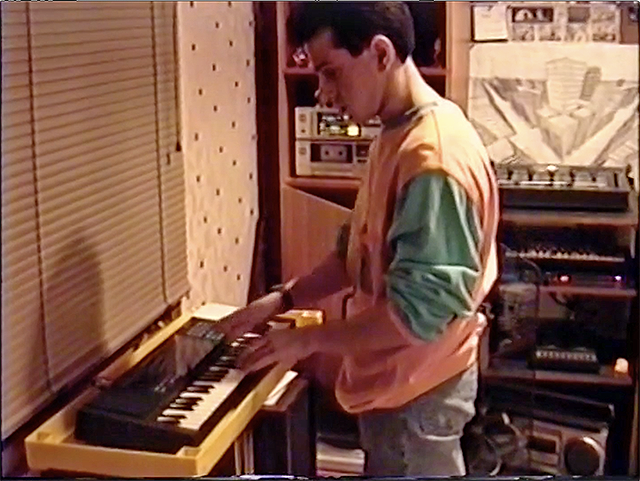
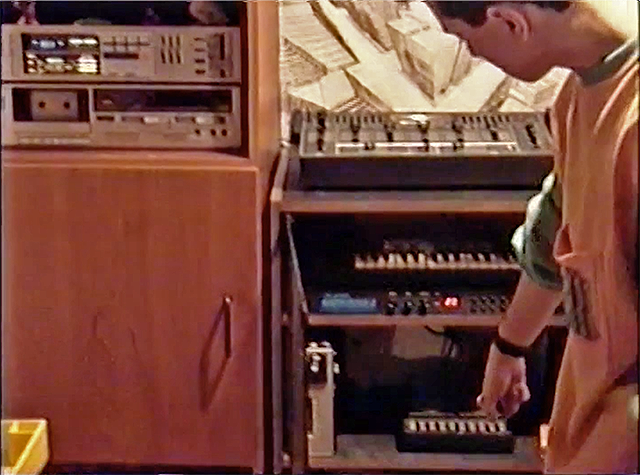
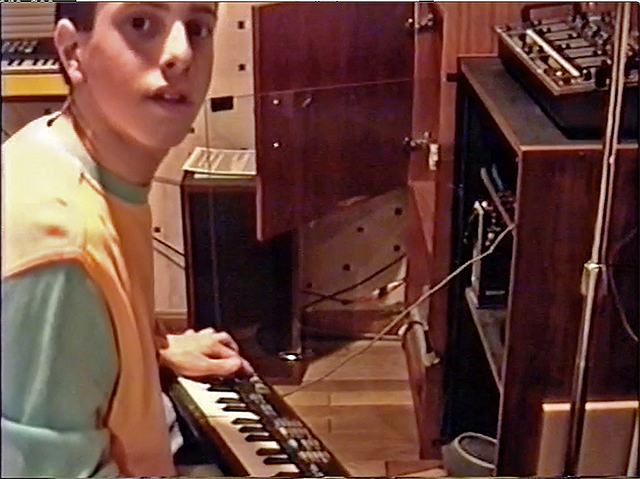


Lastly here is a shot of my bedroom around mid 1990s with my actual Ensoniq EPS keyboard
connected to my computer and Sound Blaster. Some other things to note are the SVHS deck also connected
for playing and recording, and the Blade Runner poster on the top right.

BASIC Chopper II Game I wrote two versions of a Choplifer clone in BASIC. This was a VGA version. I haven't been
able to get my keystrokes working for it in DOSBox but it loads, has instructions and music. I remember it being pretty
fun to play. You can shoot, land, and pick up people just like in choplifter. This game was large enough that I realized
I was getting to the end of what I could do in BASIC. After this I ended up teaching myself 8086/80386 Assembly since I
found a book that had a graphics chapter at the end. After that I learned C and switched to C programming but the assembly
coding knowledge helped me when it came time to write my VGA Paint program lower down on this page.
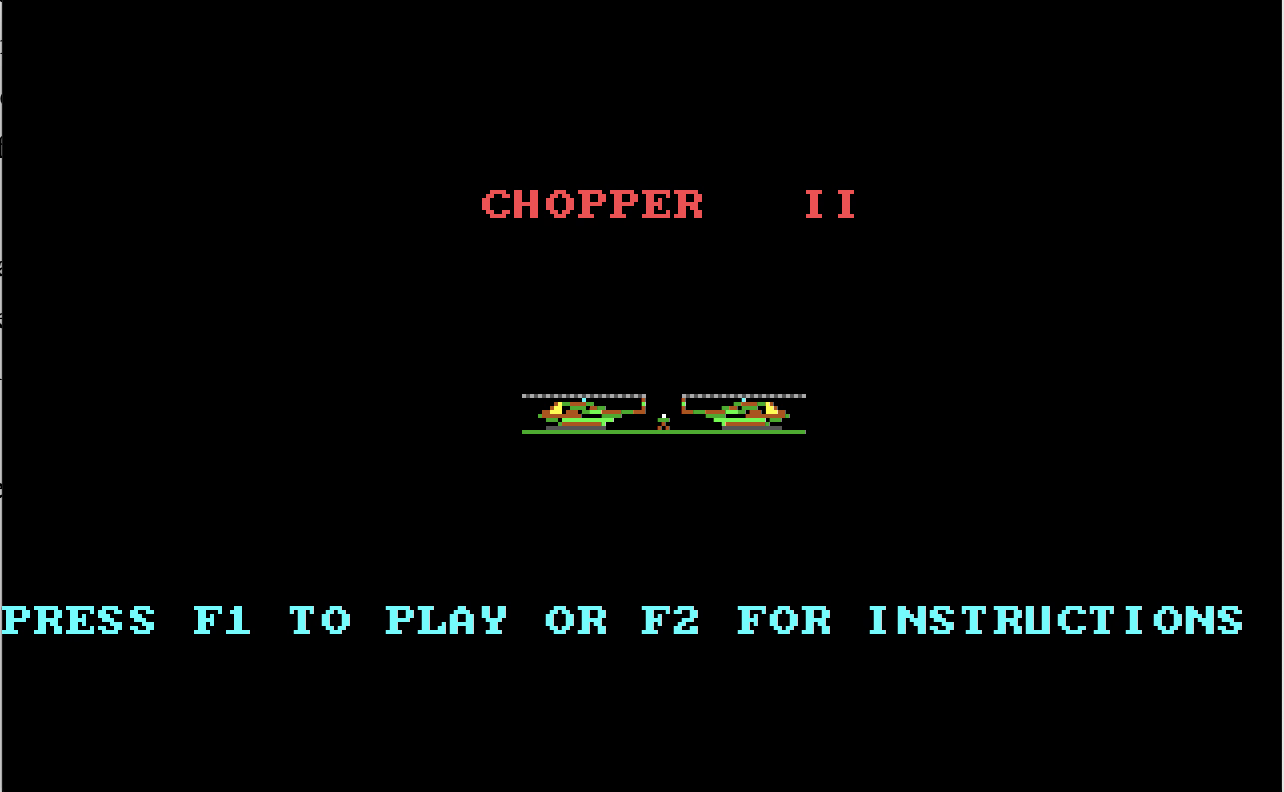
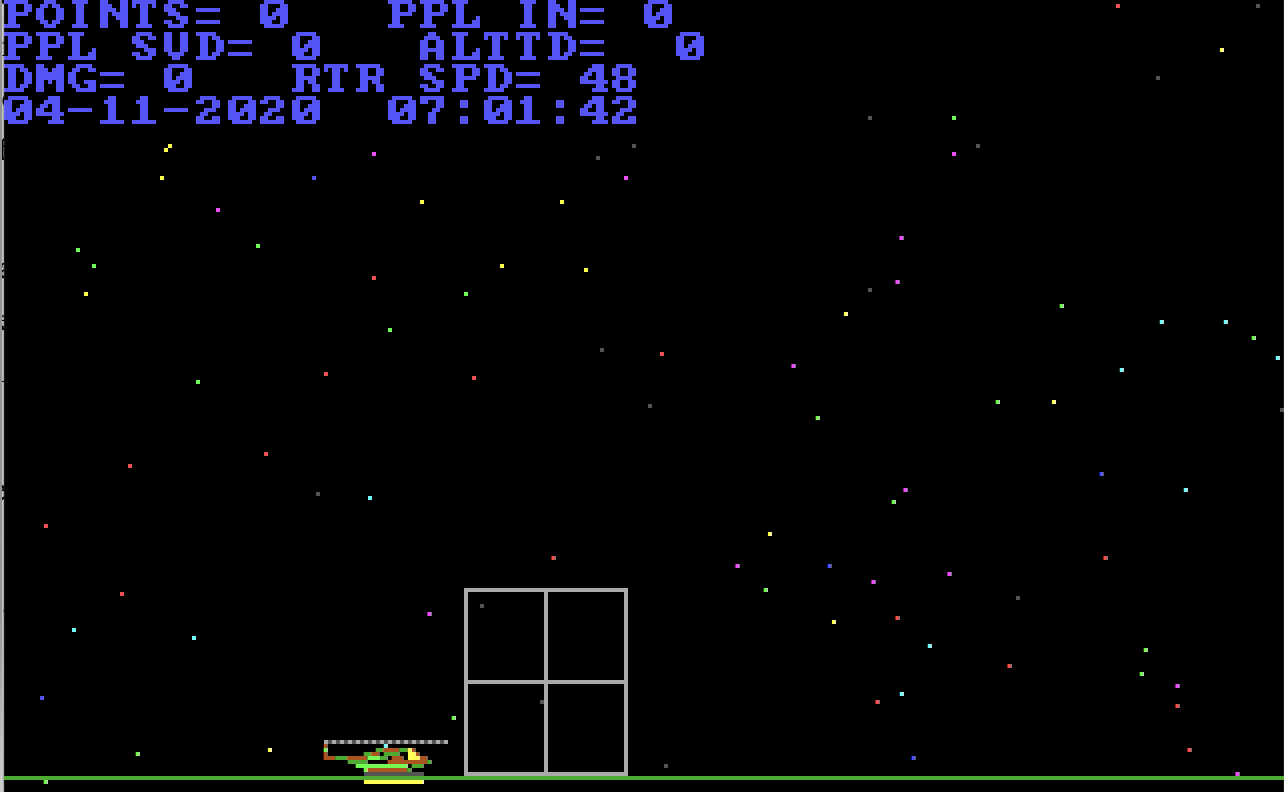
BASIC Space Shuttle CGA Space Shuttle generated from a BASIC program in 4 Color CGA mode. I don't recall if I
got the drawing data from somewhere or if I generated myself but I believe it is the latter.
CGA allowed for four colors and 320x240 resolution here.
Typically colors where Black, White, Magenta and Cyan. There were other mods that allowed for Green, Yellow and Brown.
These images are from around 1988.
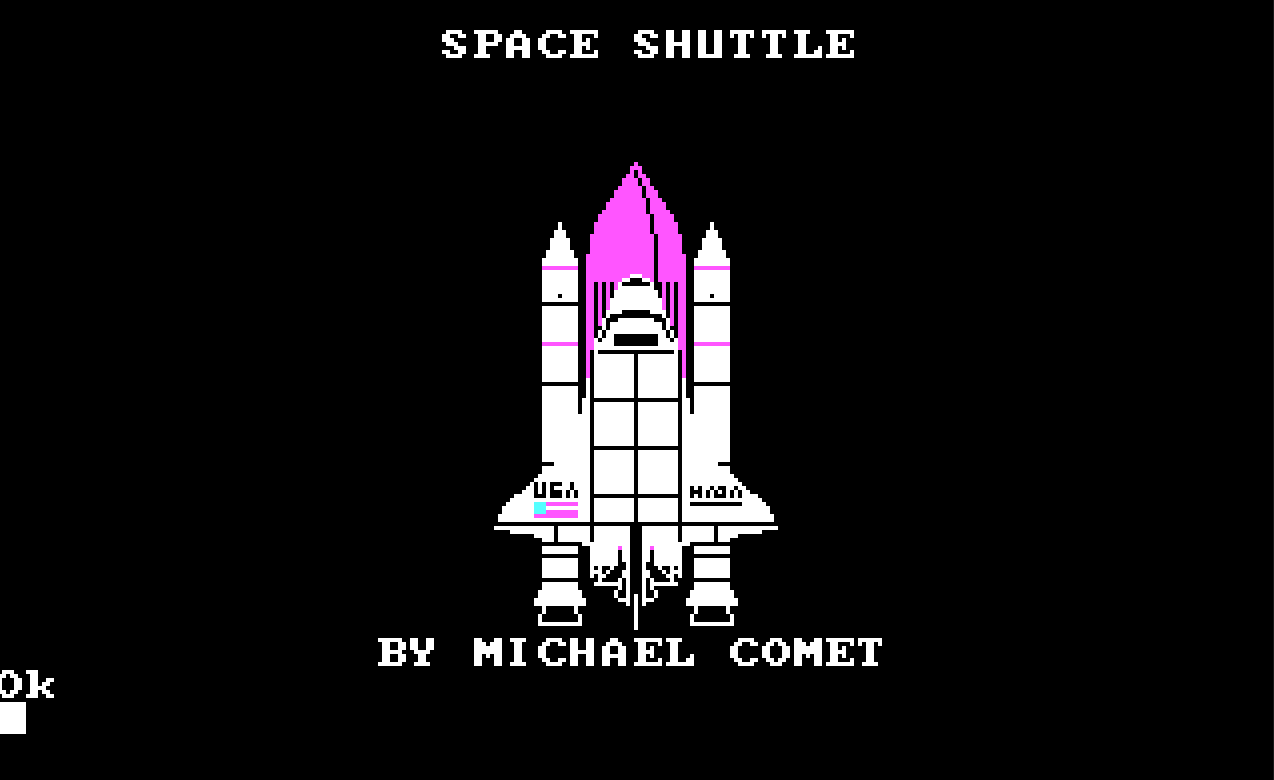
BASIC Space Shuttle EGA Space Shuttle generated from a BASIC program in 16 Color EGA mode. The EGA mode ran at
a higher resolution and allowed for more colors. This is from part of a program where there is speaker sound at low
tones for noise and the shuttle draws repeatedly as it moves up the screen. For fun I include a photo of my desk in
my bedroom from May 1982 which includes a plastic model space shuttle I put together and painted rather poorly.
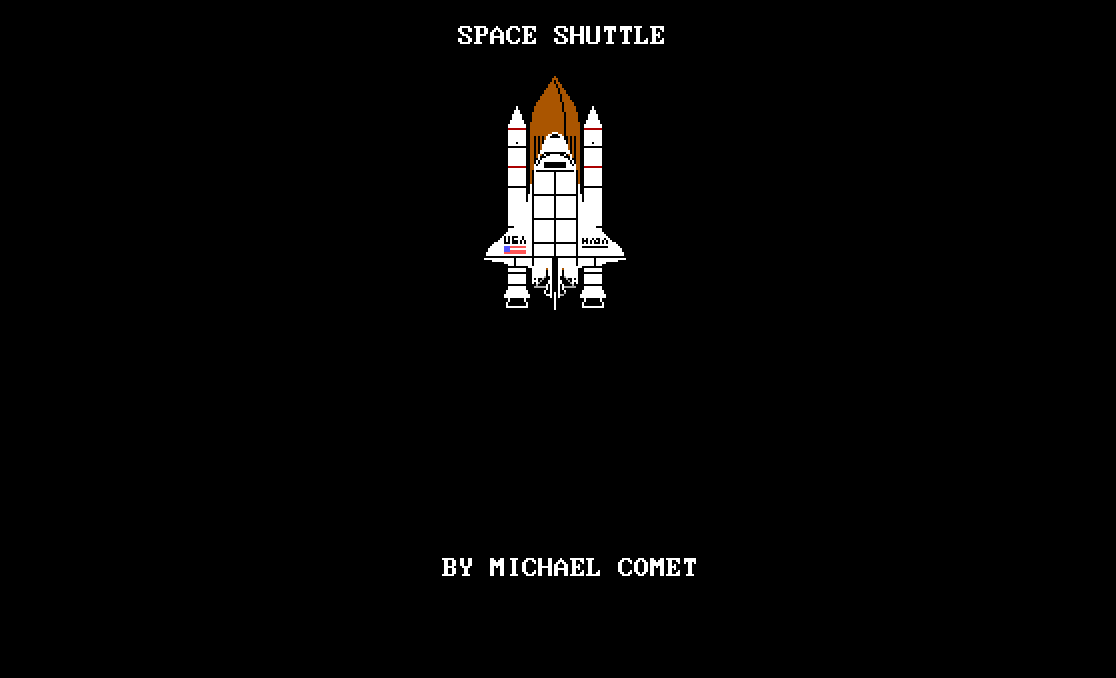
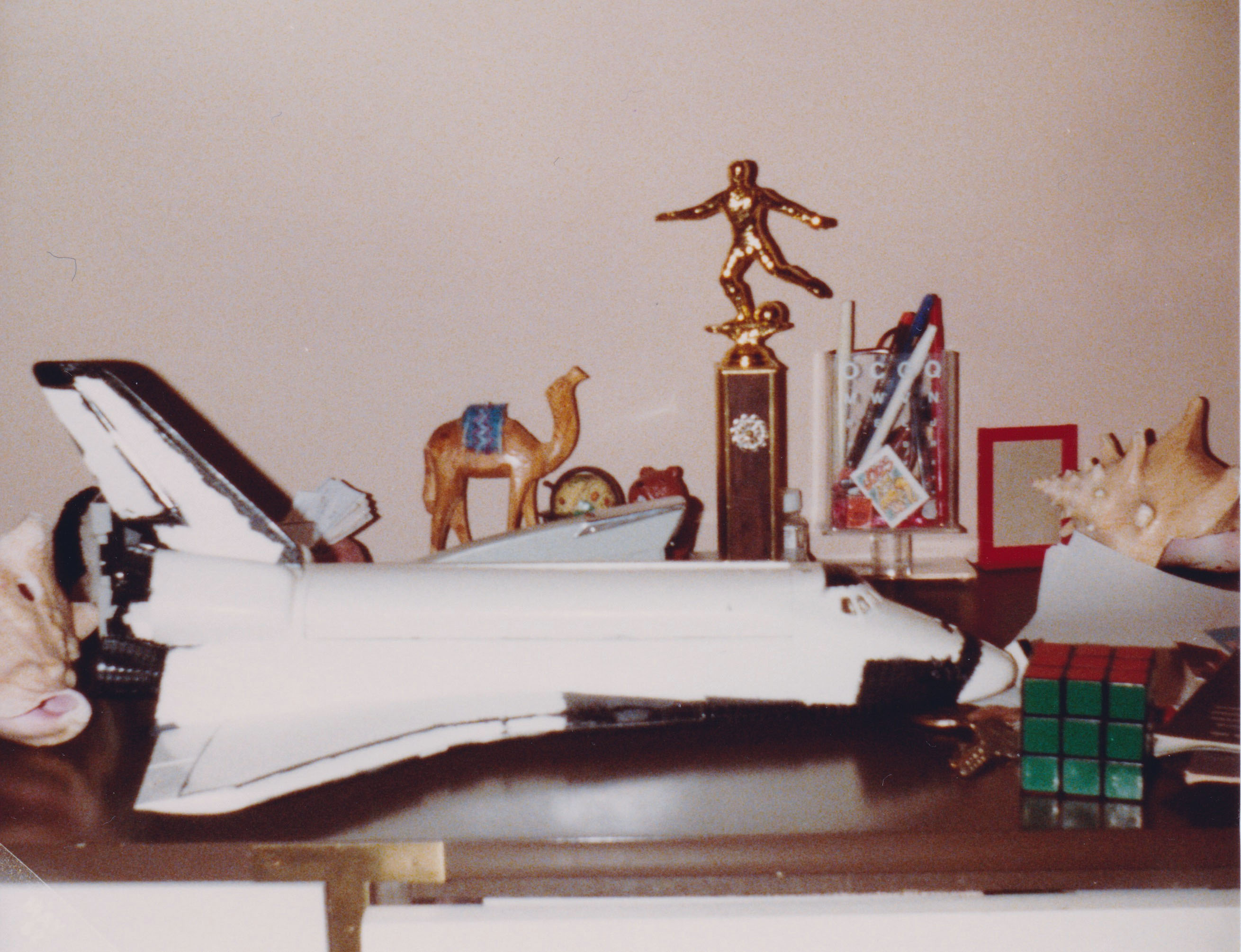
Early 3D Amiga and PC Graphics
Chrome Spheres Well, what old original late 80's, early 90's art gallery would be correct if it didn't start with some form of chrome spheres on a checkerboard floor? I remember thinking it was pretty cool to be able to get reflections, shadows and refractions all by 3D software... Though the shadows here are mysteriously absent.
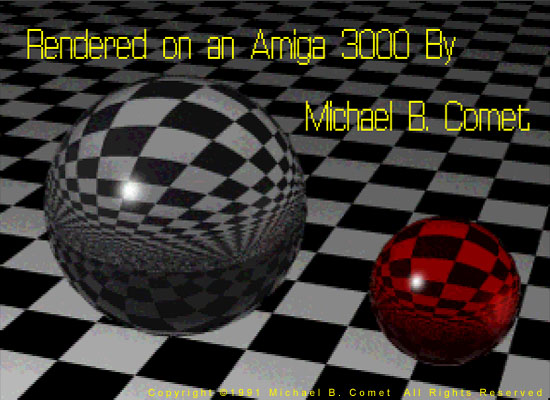
Chrome Spheres on black Probably the first render I ever did. This I believe predates the original image tho both
are likely circa 1990.
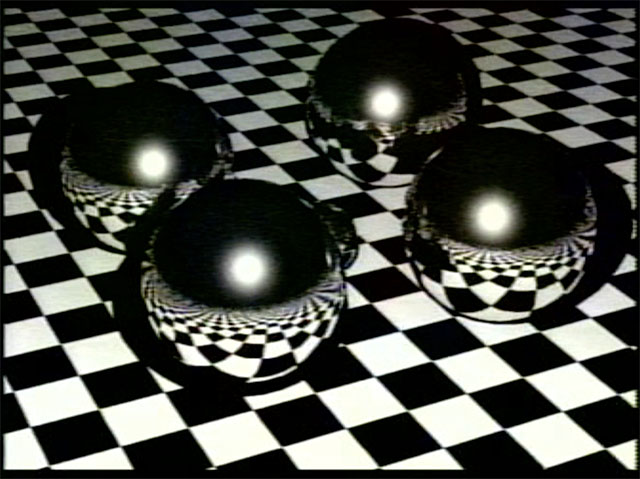
Grenades - 1990 This was the first real model I ever made and animated. Done in Imagine 1.0 on my Amiga 3000 I remember working on this while the computer was still on our kitchen table as we had just gotten it a week or so prior. My father was directing me on what changes to make and such. I have an animation of the pin and ring being pulled out and the grenade rotating and then exploding into triangles. The latter was a feature of Imagine where every triangle could scale out independently for explosion look.
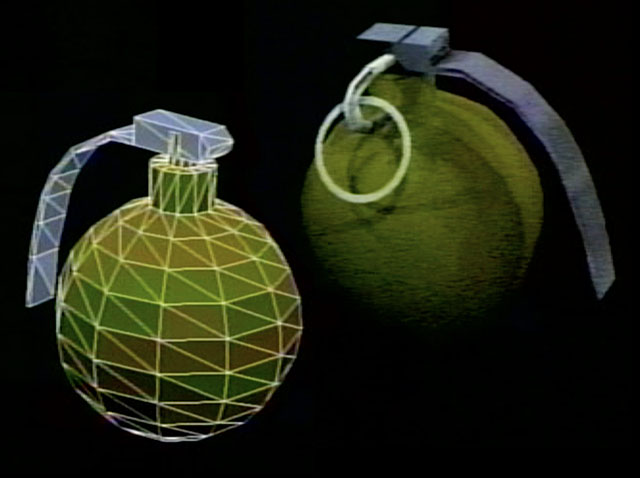
Camera - 1990 One of the earlier models I attempted of my old Nikon 35mm camera.

Chrome Tops 1991 This is a pretty old Image. Done using Imagine...probably from 1991-1993 sometime...I'm not exactly sure. It was the good old days with chrome and ray tracing. Though at least I was smart enough not to use a checkered ground..hehe.

Chrome Tops 1995 I actually liked the colors and composition of the original image so much, I redid it with Imagine later on. I'm not sure if this was one of my last Imagine versions, or if I had switched to Lightwave by this point, though I think it was still Imagine r3.
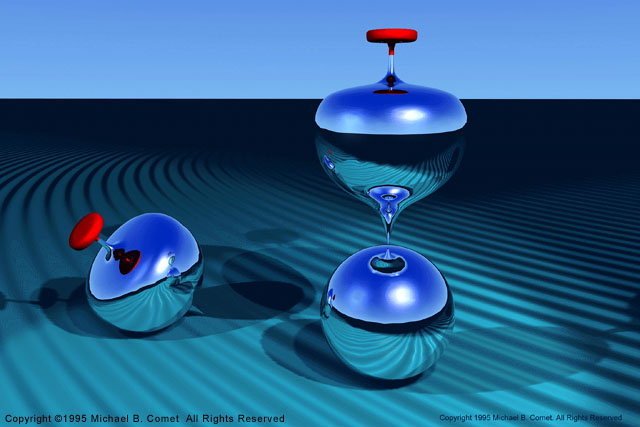
Refreaction Testing what I think was Imagine and how refraction as well as reflection would work.

Imagine Logo Old Logo from Imagine 3D app I generated. Photo of my old monitor. The old version of Imagine had
a bug with edge smoothing hence there was faceting even on the side faces.
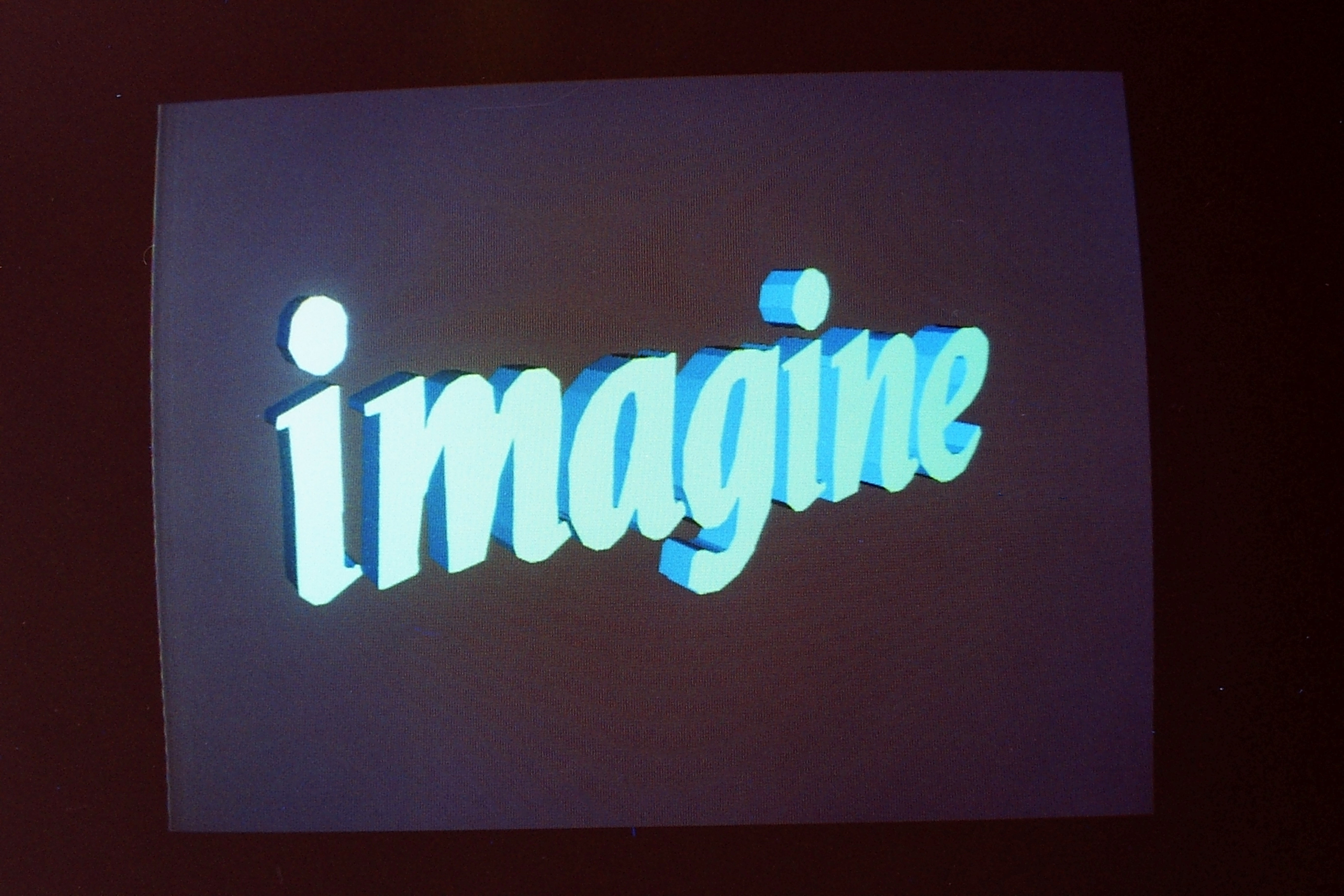
Wood Bowl 1 Wow, I can lathe! Amazing modeling! That with a nice ugly checkerboard floor, and built in procedural wood textures, this all made me a pretty basic beginning 3D artist at this stage. I guess I was quite proud of having an Amiga back then, as I tacked that text onto the image after it was rendered.
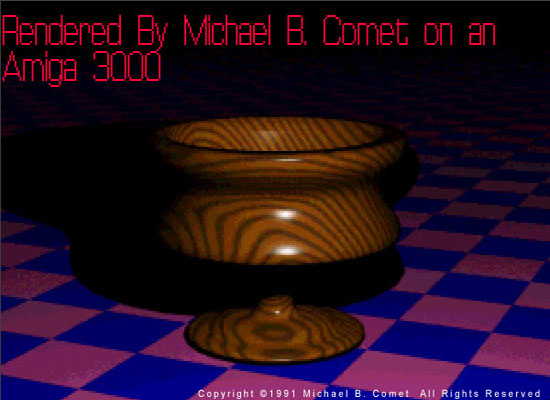
Wood Bowl 2 This is the cool 'Zebra' variation of the original model. At this point in 1991, I was basically trying to still understand '3D' and the software in general, and learn the tools, and how to create models, and lights etc...
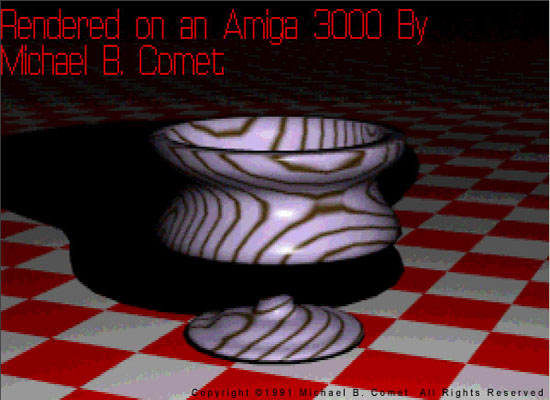
Star Twist A simple star model extruded and twisted as I was learning how to model.
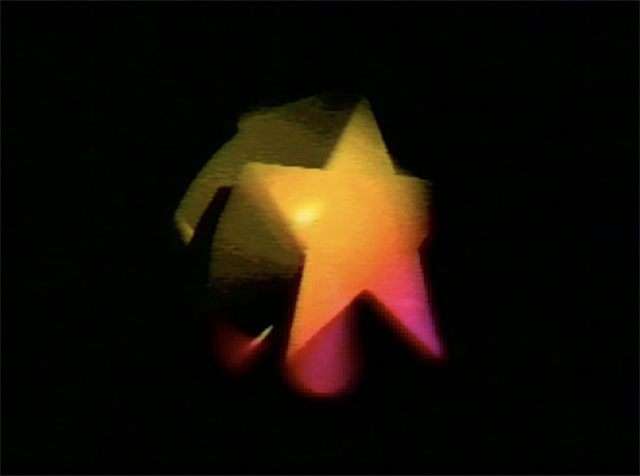
Graphics Early Models Some of my early and first ever attempts at modeling in Imagine. I am guessing around 1990-1991.
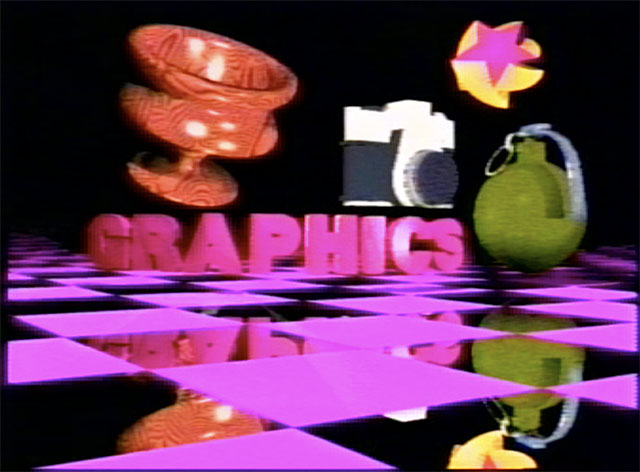
Early Amiga 3000 model - 1991 Very early attempt at primitive modeling with Imagine of my Amiga 3000.
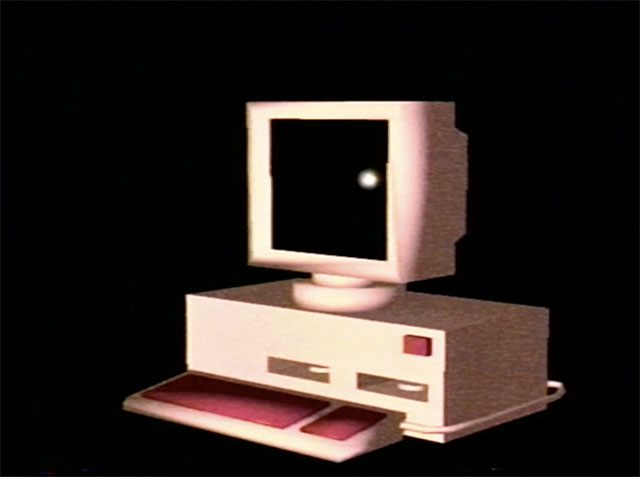
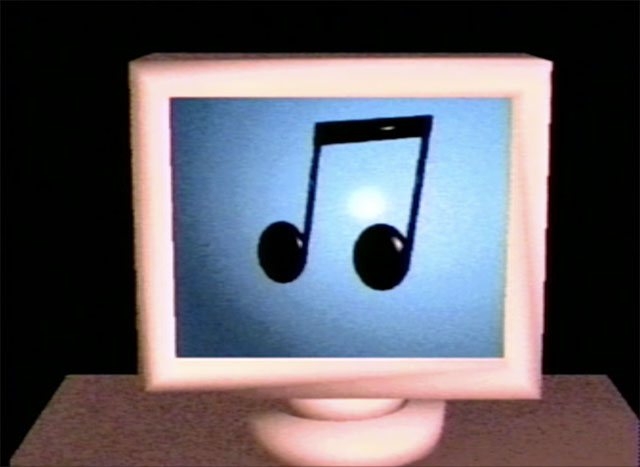
Camcorder Model - 1991 Another early model of my dads Panasonic video recorder. You can see a real photo of me and the camcorder on top of our editing rack lower down on this page.
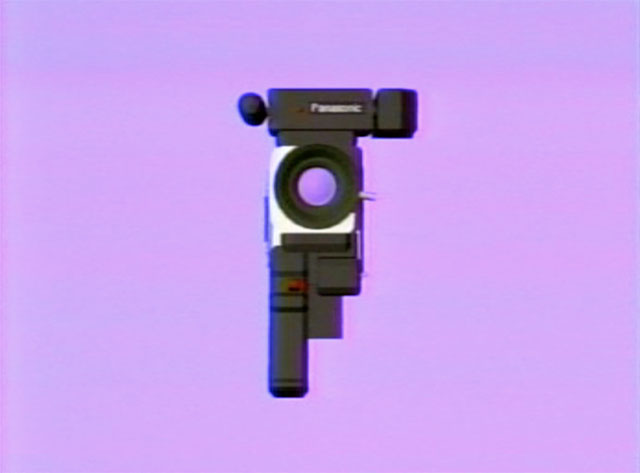
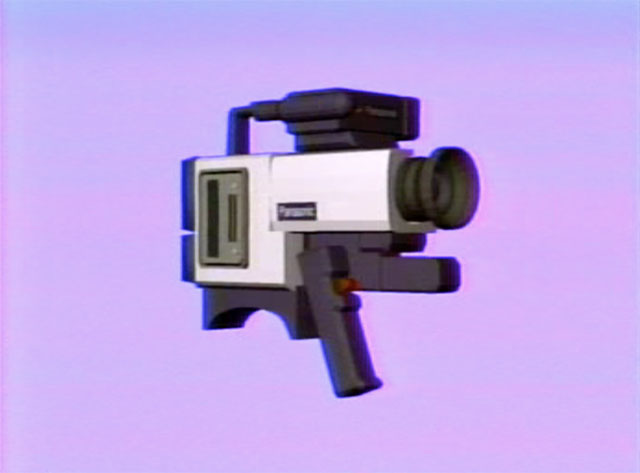

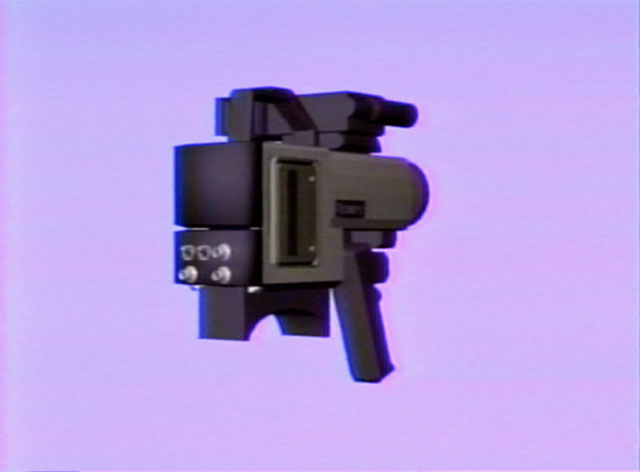

Spotlight Early testing of prims and how to cheat a spotlight. Since there was no such thing as volumetrics this was just a scaled cylinder with a semi transparent texture map to cheat the look of a spot light connected to an actual light. Probablt circa 1990-1991.

Vase One of the early vase models I created. Spotlight was created by using a transparent cylinder and spotlight.

Flying Tank Modeling a flying tank with simple shapes. Not sure what year this was but probably 1990-1991 or so.

F14 Tomact Very early modeling with basic shapes in Imagine probaby 1990-1991 of an F14 Tomcat...because Top Gun. It's time to go ballistic Mav!
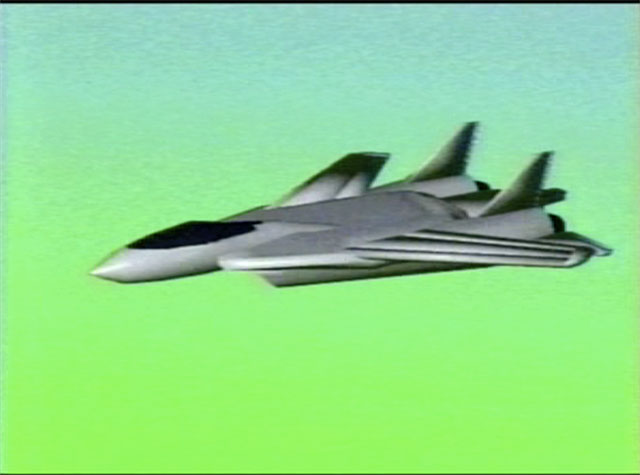
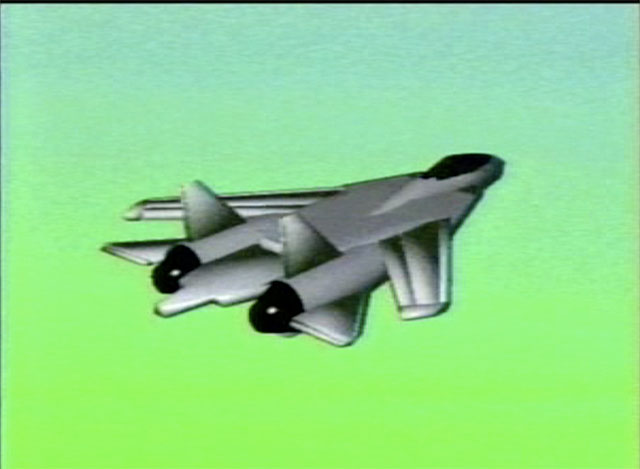
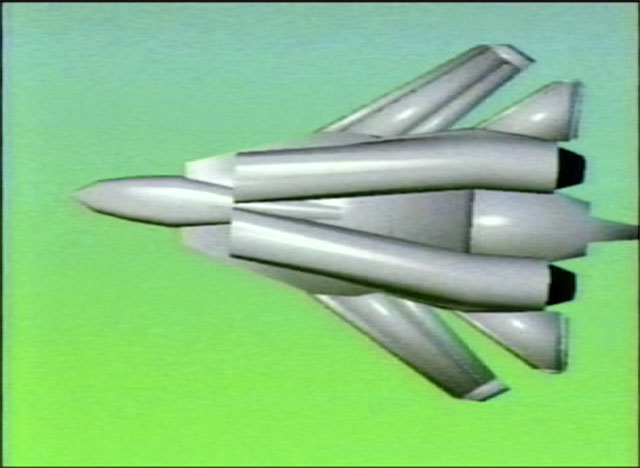
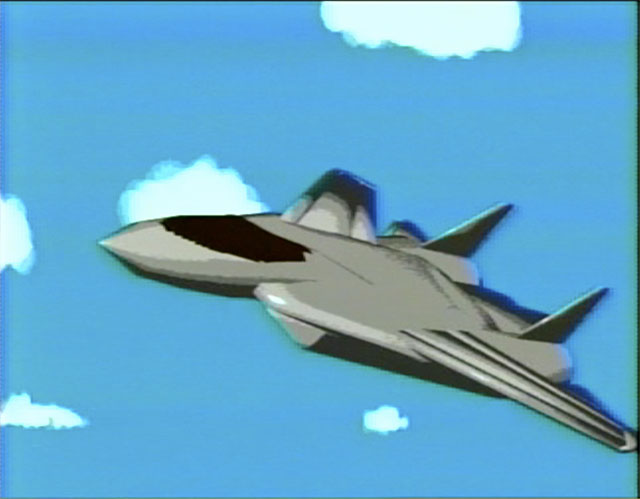
Chrome Texture A render I did for more artistic style of yet another chrome sphere but on a texture map I generated. Probably around 1992-1993.

Robot and Gun Another early model made in pieces so I could animate the arm coming up with the gun.

Chrome Ant This was actually a fairly early image I did back in the early days. I remember working on it in my parents family room, while my Dad did video editing with his Video Toaster. Created around 1992, maybe a little earlier. I just stuck a few basic objects together, set the sky and ground, and set it to ray trace...
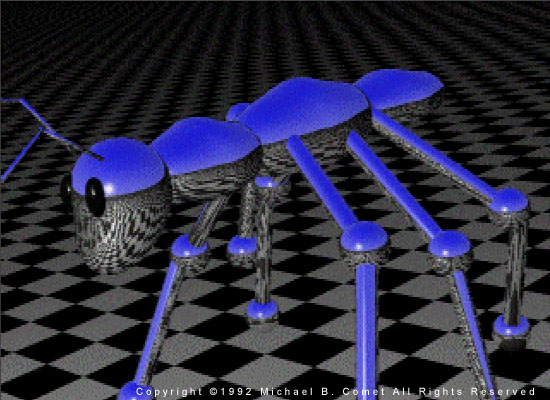
Swords Another basic model probably 1991-1992 or so.
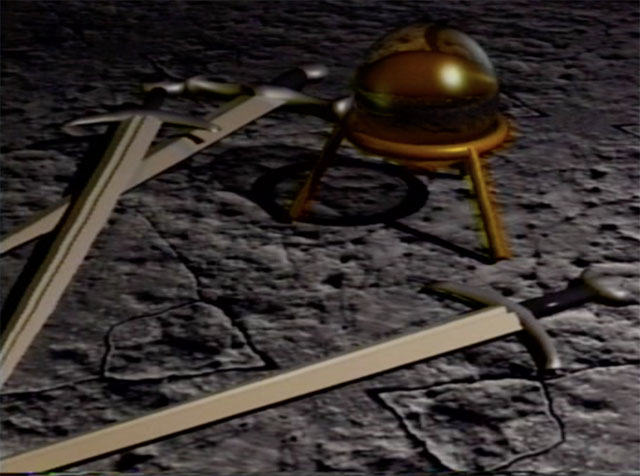
AnimaPaint Title Page During High School I wrote a full fledges 320x240 VGA 256 color paint program in C. This was a true 8-bit pixel style paint program similar to Deluxe Paint. I decided to write my own for DOS as I wanted to have a way to create graphics for my own games. I probably should have sold it back in the day, heh. Everything from menus to features had to be entirely hand coded as there was no sort of front end UI libraries. The entire program consisted of blitting raw data to a memory address while in VGA mode.

AnimaPaint Title Page The title page had the logo color cycle (a feature within the app as well)

AnimaPaint Main Interface This is the main interface of my paint program, defintely a rip off of Deluxe Paint from the Amiga I was using too.

AnimaPaint Brush Menu Example Brush menu that I coded.

AnimaPaint PCX Loading I coded my program to load and save PCX images as well as a variant of my own devising. This is a sample Rose photo that I think was part of an early photoshop or dox computer I had bought.
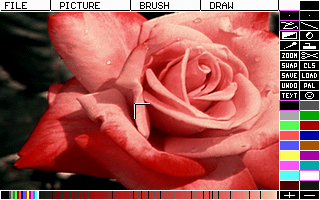
AnimaPaint PCX Sphere Image An example of how I would load renders I made on my Amiga back on my MS-DOS computer in my own coded paint program to add text.

AnimaPaint PCX Chrome Ant My Ant render loaded from Amiga back into AnimaPaint MS-DOS paint program I wrote. Notice how the color palette on the bottom changes as needed when the images are loaded since only 256 colors existed at once then.

AnimaPaint PCX Filling Samples Example showing various fills and gradients. Some of the fill type styles were included in the Borland C program I was coding with and I added the ability to change pixel color index to get gradients made as well in my paint program.

AnimaPaint PCX Lamborghini Diablo This was a PCX image 256 color loaded into my paint program. I believe I digitally scanned this from an old car magazine in the 90s using an old flatbed scanner we had.
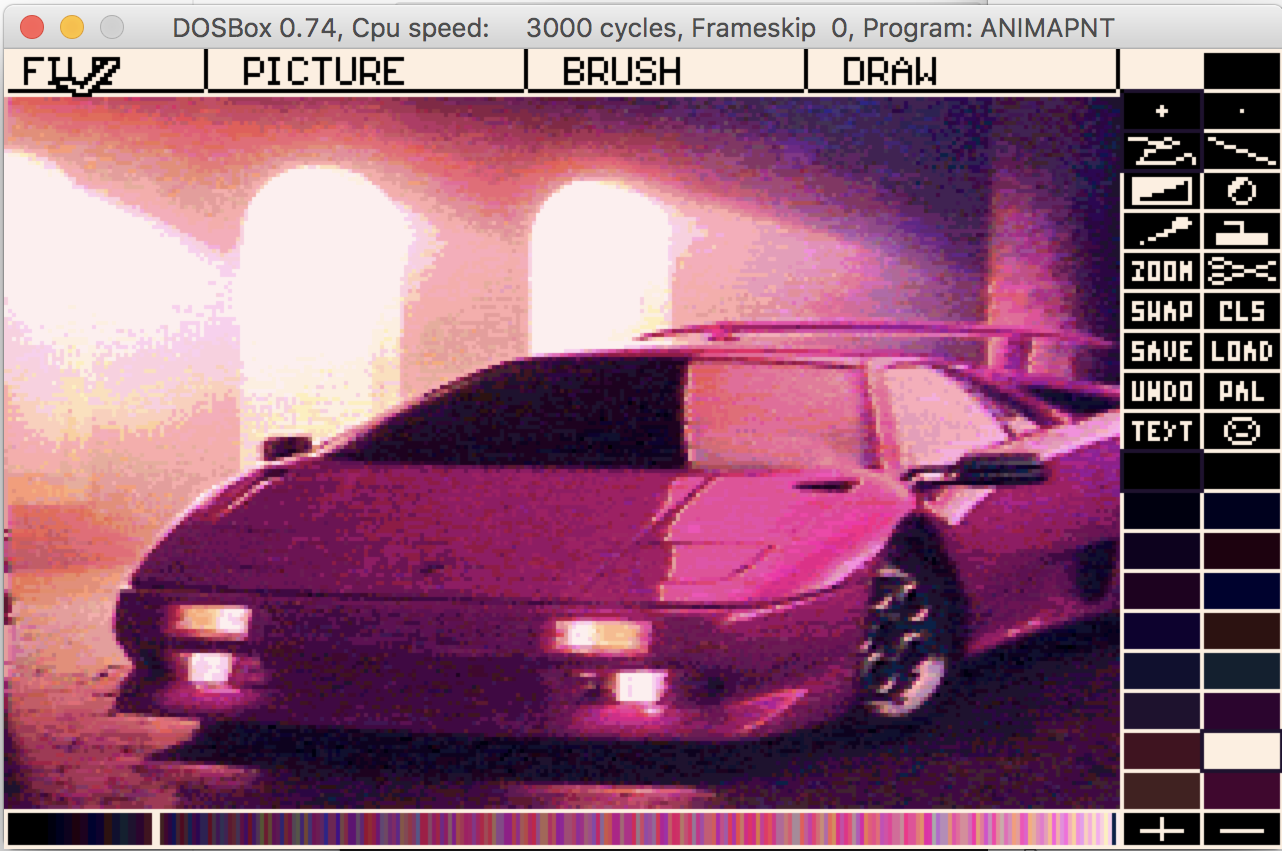
AnimaPaint Font Menu This is the font choice page in AnimaPaint. While fonts were provided as a part of the Borland C I was using I also coded the ability to scale up or down. At the time keeping it to exact multipliers. I also coded an emboss feature to allow for the user to more easily shift up and down a pixel for a lighter and darker color.
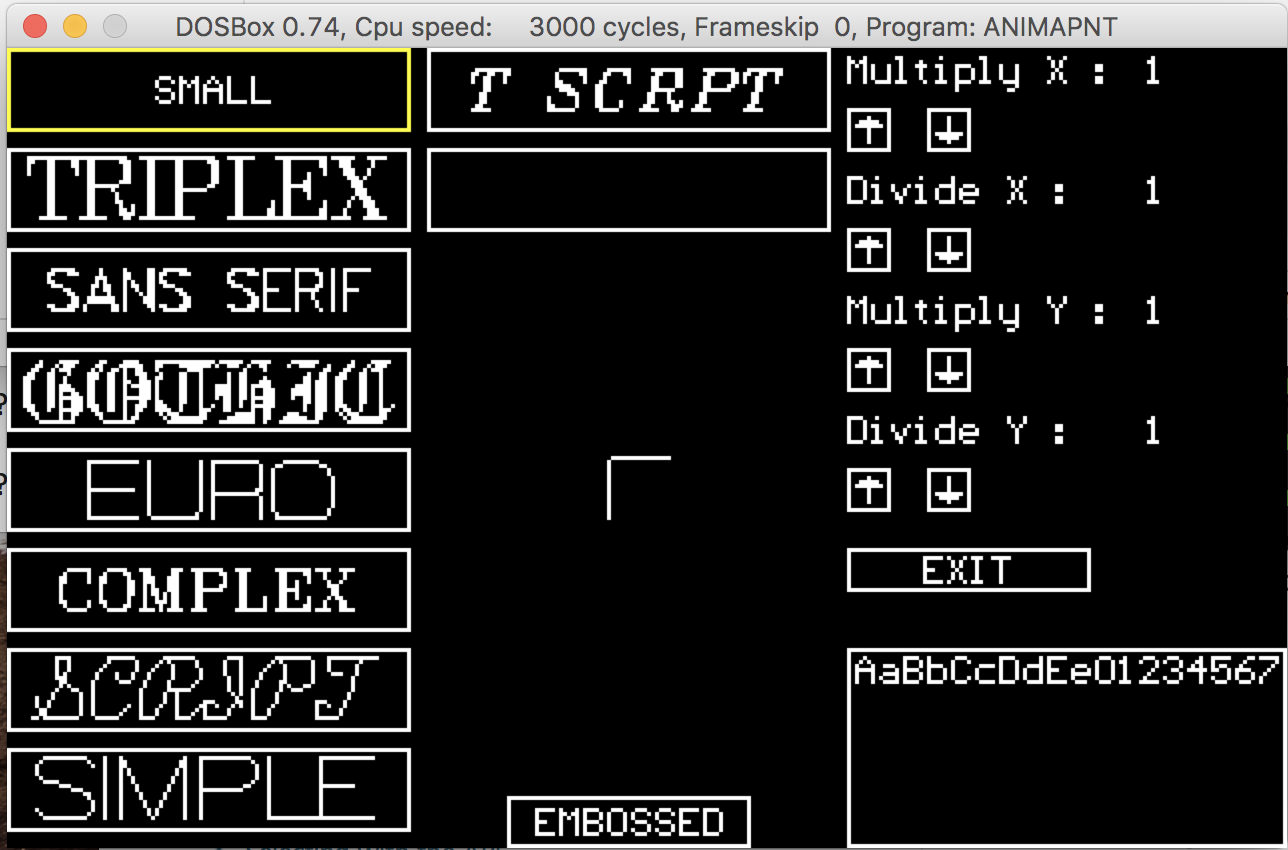
AnimaPaint DOSBox Testing Me testing DOSBox with my old paint program happy to see it working again.

Gems Cover This was a title screen for a magazine my brother Ari and I worked on called the 'Graphically Enhanced Magazine'. I was doing a lot of C programming in my free time. I wrote my own 2D paint program and used that and my programming to write a text based magazine with custom menus and graphics in 1992.

Gems Menu Page Sample menu page from the self executable text and VGA magazine I programmed. This app still works under DOSBox emulation.
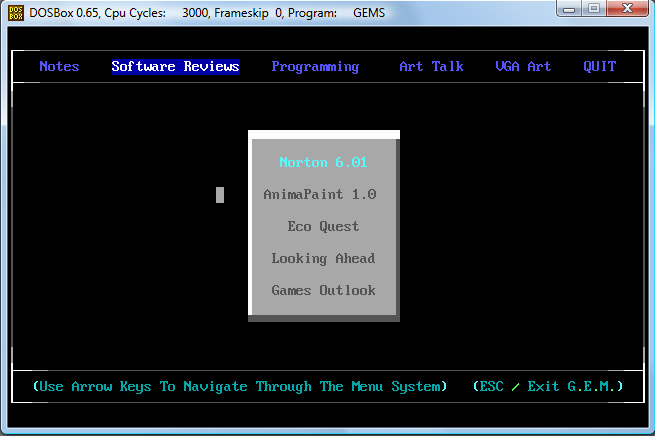
Gems Article Page Sample page from the self executable text and VGA magazine I programmed.
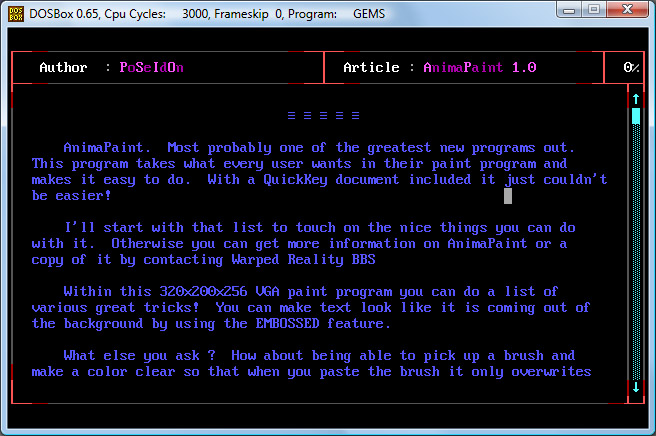
Gems Ad Page Sample add graphics page from the magazine I had coded. This one for an old dial up modem download side.
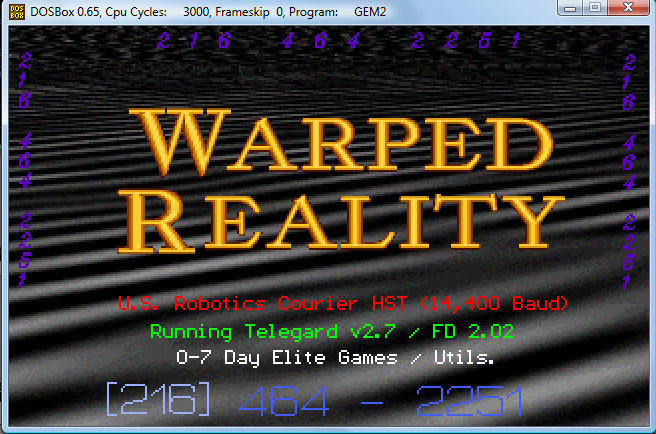
Gems AnimaPaint sample A sample picture promoting my AnimaPaint program in GEM
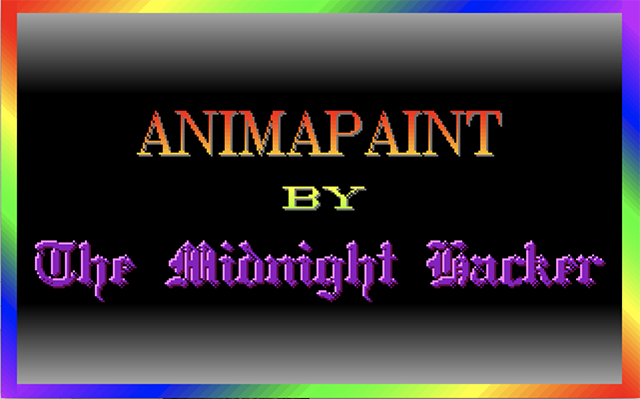
Gems Closing Page End page from the self executable text and VGA magazine I programmed. Amazing font from the old Borland Turbo C kit that was part of my AnimaPaint VGA Paint program I wrote to create all the images.

Vase - 1992 Simple lathed object with bent cylinders for the arms inspired by a Lightwave model. I textured it with a rock map, but then started playing with colored lighting. This was kind of the beginning of me really starting to learn about basic 3 point lighting, warm and cool colors etc...
Shrine This is an old Imagine 2.0 render. I found the readme file for it, and here is what it says: Shrine.jpg is an image of a fantasy shrine set in a valley. The image was rendered entirely in Imagine and touched up in Light 24. Background mountains were imported using VistaPro 1.0's save as Turbo Silver object function.
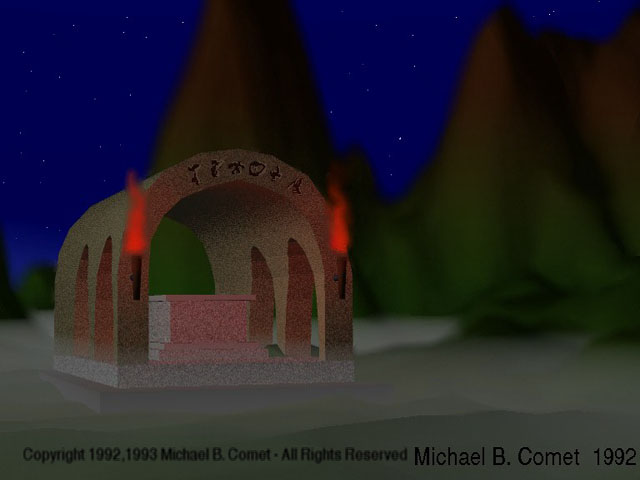
Temple 1 This is a really simple image I did with Imagine. Pretty much basic shapes twisted or edited for this animation I did. It was a good test of basic software modeling knowledge, and for playing with lighting. I used this scene as a test when I switched over to Lightwave, and then MAX to see if I could recreate it.

Temple 2 This is another angle of the temp animation I did. The fire was created by a simple cylinder object mapped with some fractal noise for transparency and color.

Forest This image was submitted to the Imagine Mailing List contest, where it took first place in the HAM (4096 color) category. This image is a re-render in 24 bit mode. The background sky is a drawing I did with Light24 program and Firecracker24 board.

Mecha An attempt inspired by anime for some very early model and animation work. Yeah...funny. Probably circa 1993-1994.
Alien Vacation This and the Bathroom image next took 2nd place for an Imagine Mailing List contest way back in 1992 or 1993 or so. Most of the objects are obviously pretty simple, sphere for the alien, with cylinders bent into shape. And deformed planes for most of the rest of the parts.

Alien Vacation Solid Screengrab - aka actual 35mm photo of my monitor showing solid shaded version of Alien scene.
Lines on the top right of the image are due to actual photo being damaged in storage... yes it's an actual photo of the screen.
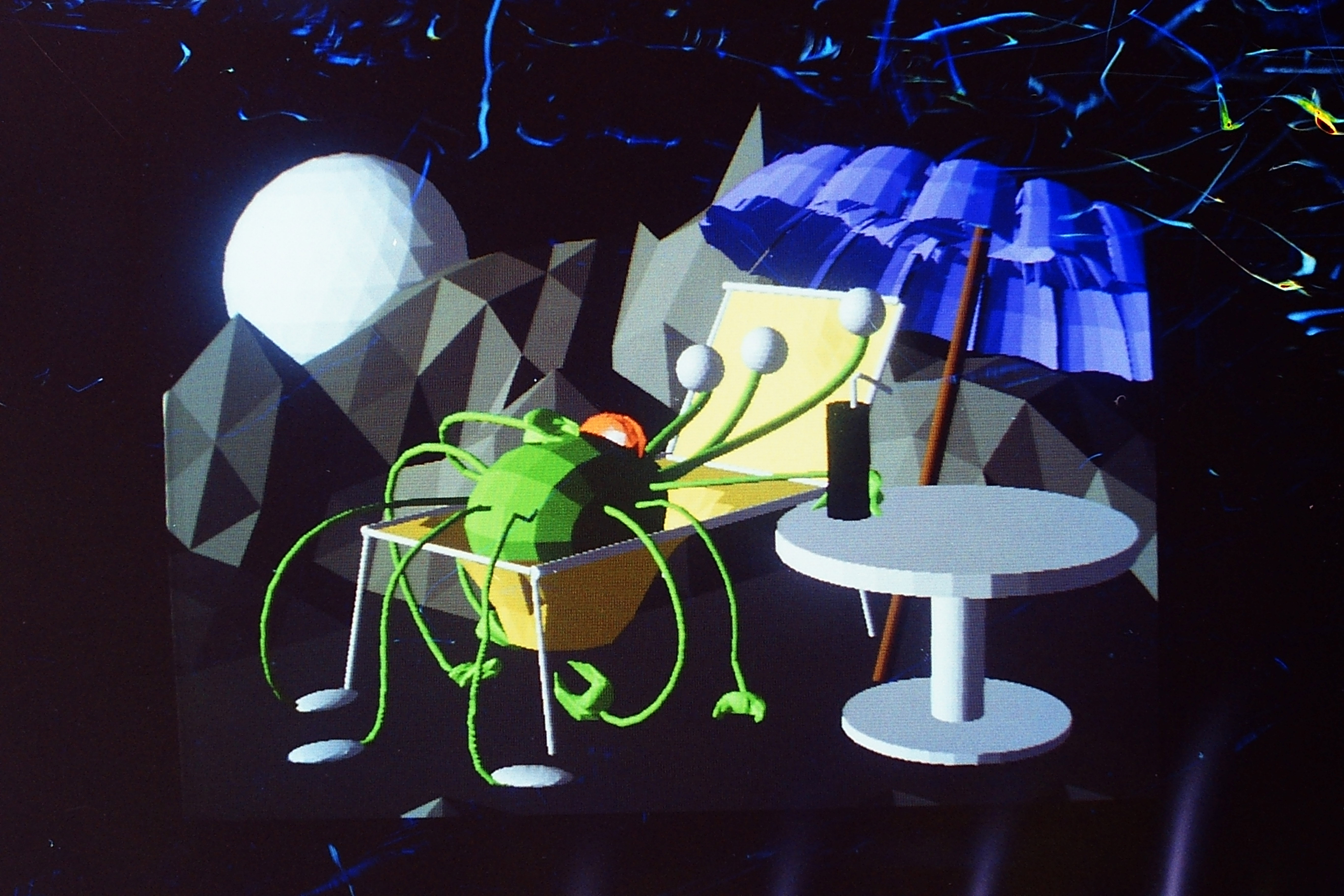
Bathroom This done with Imagine 2.0 on my Amiga 3000. This, my Alien Vacation, and some one elses entry all had a 3 way tie for 2nd place in the Imagine Mailing List Contest. I had like 10-20 lights probably to get the effect, most Ray Traced since that was the only way to get shadows.
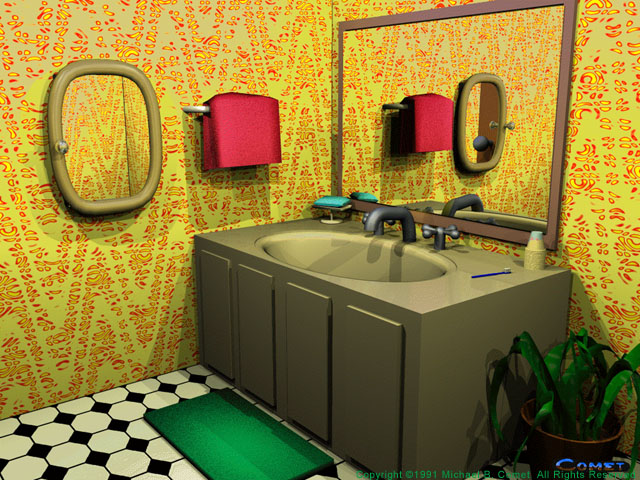
Bathroom Wireframe Screengrab - aka actual 35mm photo of my monitor showing wireframe from the Bathroom scene.

Bathroom Solid Screengrab - aka actual 35mm photo of my monitor showing solid shaded Bathroom scene.
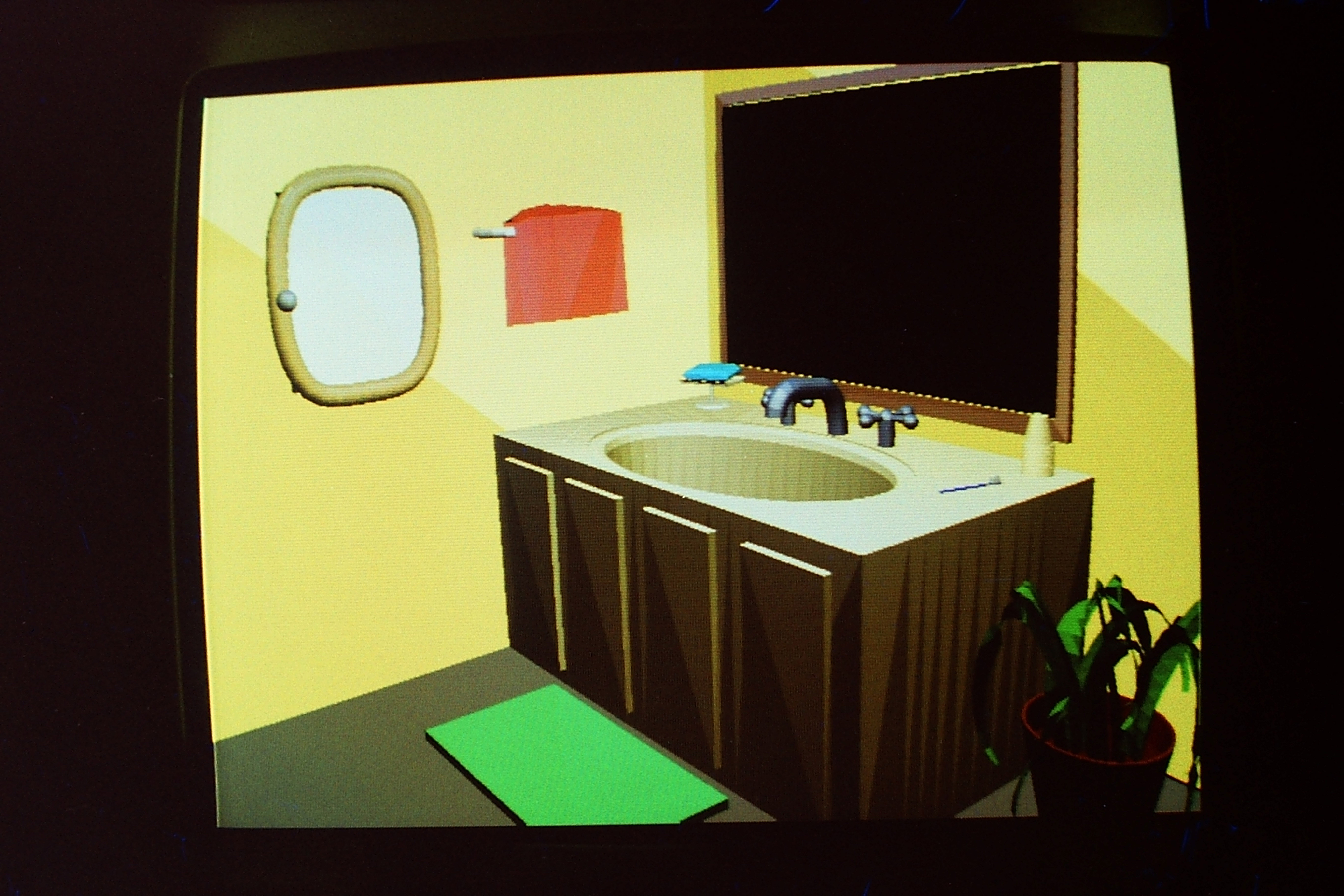
Video Toaster Edit Rack And old photo of me probably circa 1991-1992 or so at the large edit rack my dad assembled for the video toaster. While I primarily used my own Amiga 3000 and Imagine, I also played with the Video Toaster and the original version of Lightwave 3D. We had a prosumer setup with two S-VHS Panasonic decks, a large Panasonic camera on top under the towel, and physical switcher along with monitors and the Amiga 2500 for the toaster on the bottom.
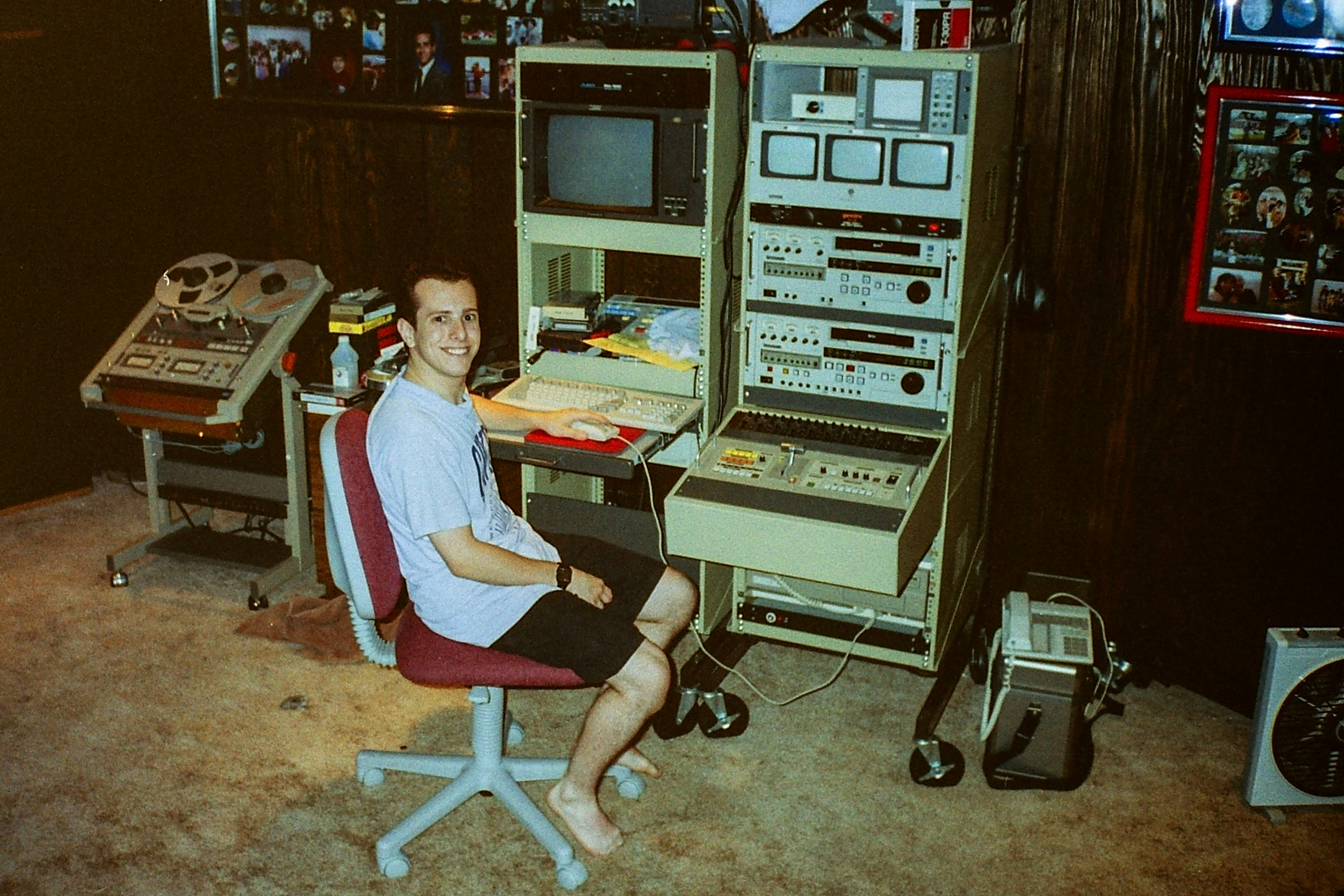
Amiga 3000 and Me - 1991 Me with my Amiga 3000 working on graphics and titles for a home video behind our couch while using and audio mixer to help my dad do some audio work for the video. Note the T-Shirt that says Lamborghini with a black countach on it. (hard to see but I remember - ah the 80's). This is from June 23, 1991. That's a small portable CD-Player/Walkman or a Mini-Disc player I believe connected to the mixer.
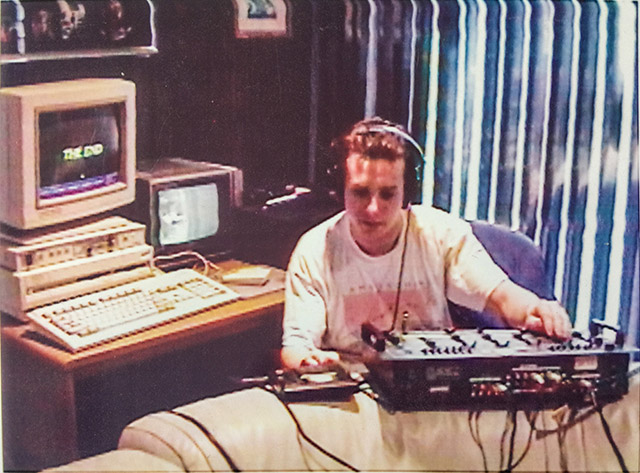
Here is a better quality image clearly noted from around June of 1991. Ah yes teenage acne. And you can more clearly
read the T-Shirt for the Lamborghini text.
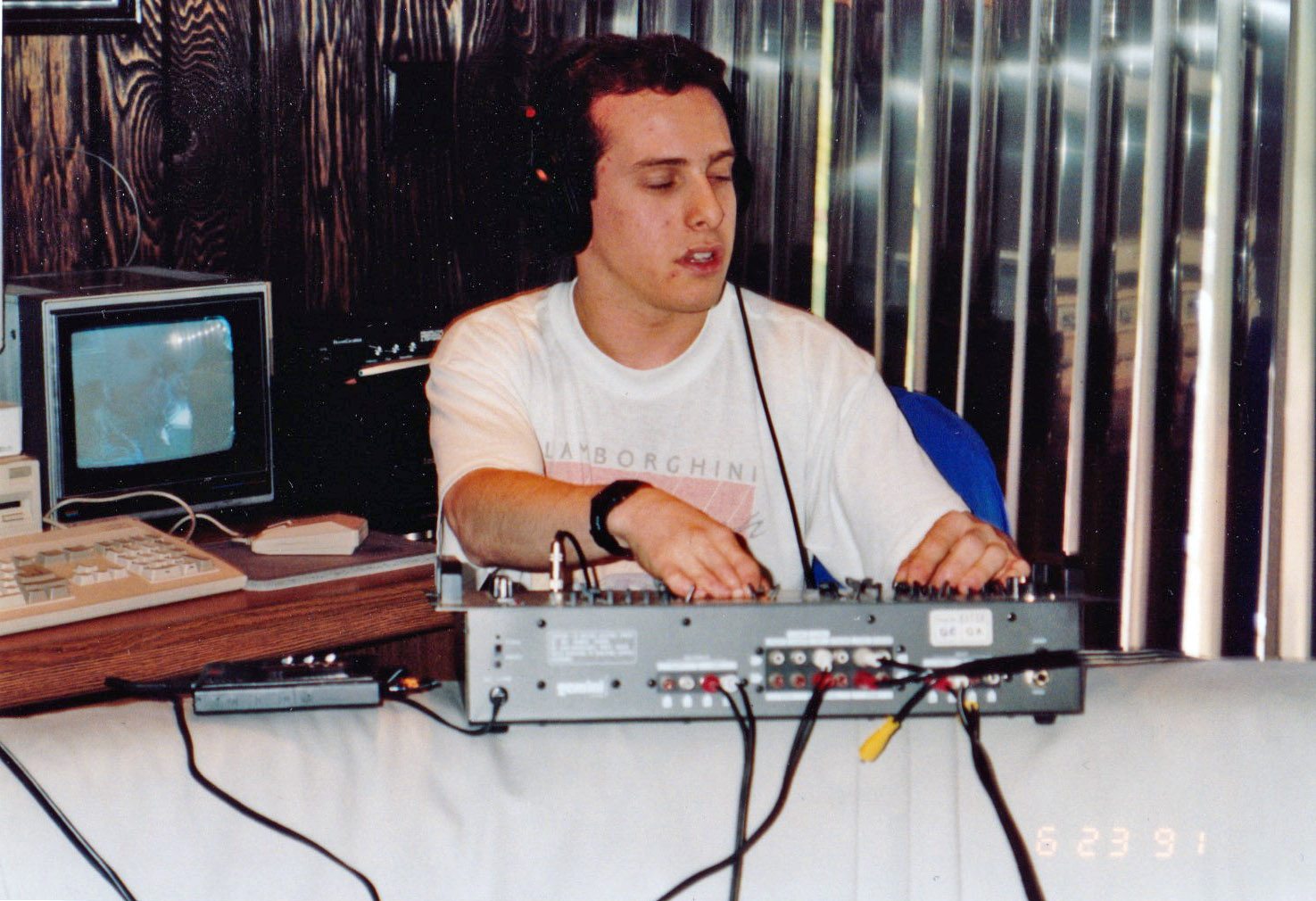
Another angle showing my father with the large Panasonic video camcorder and me in the background.
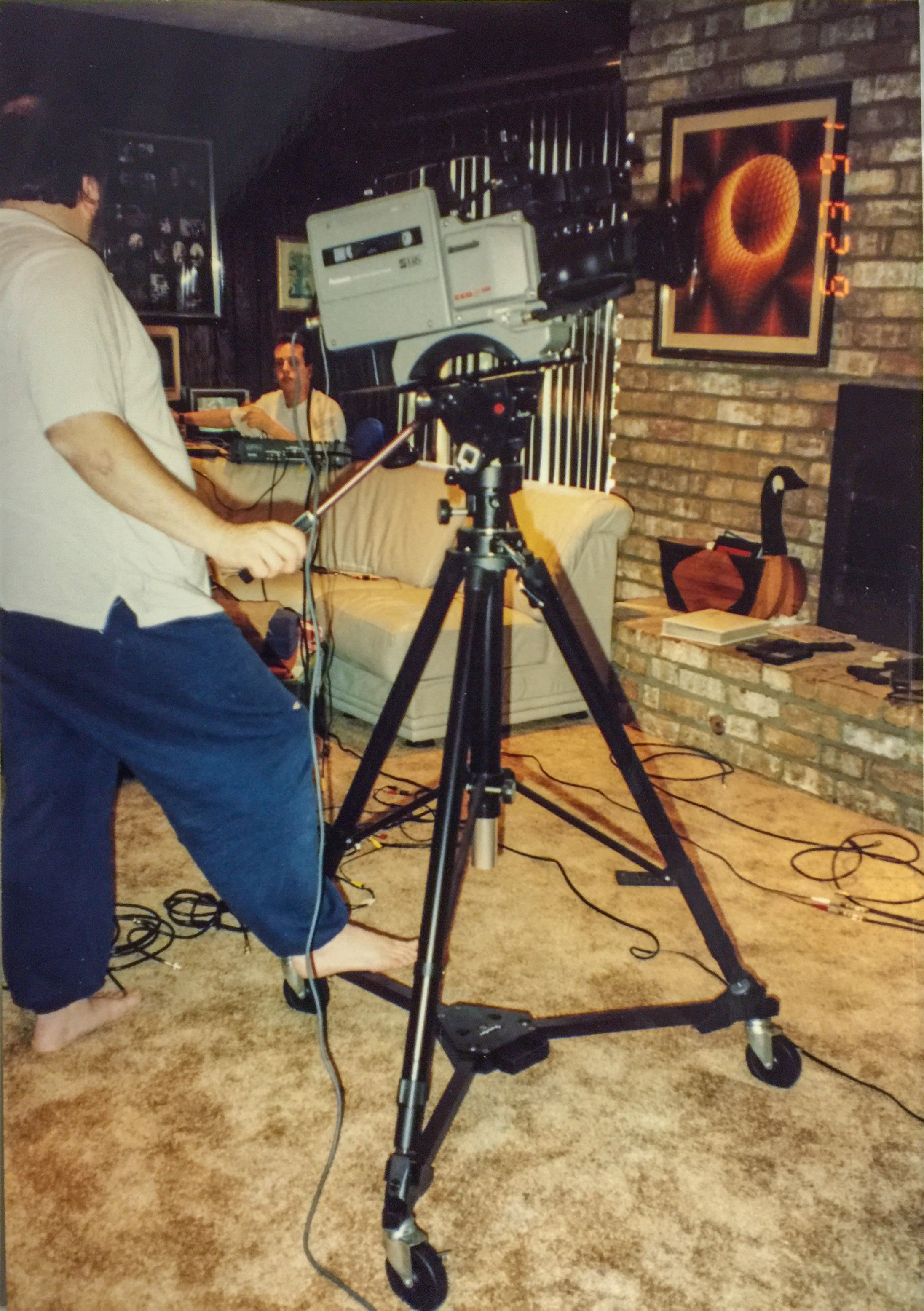
I just found some video of this actual event - apparently we were editing a video for one of our cousins.
Here are a few more grabs off of the VHS video. The night before and then the next day with close up of
the Countach shirt and such.
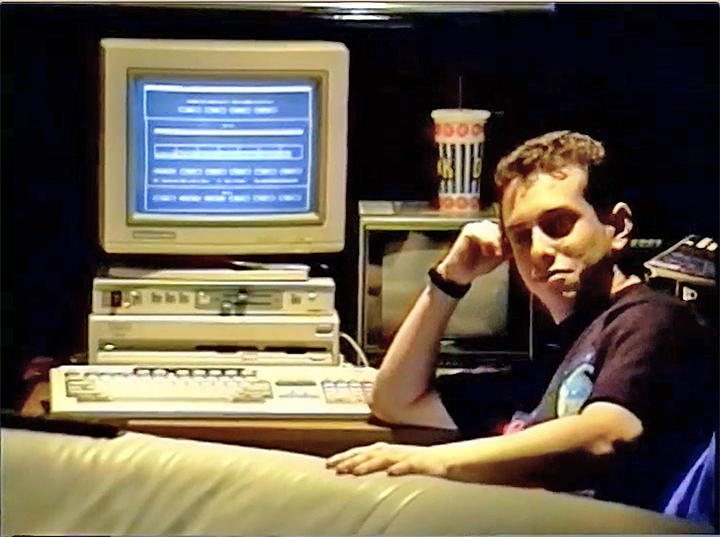

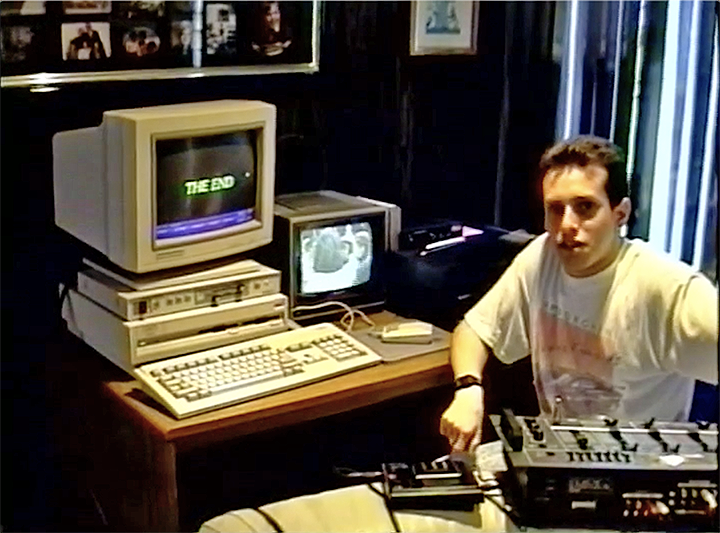
Dragon 1 This is one of the few actual 'characters' I did back in the old Imagine 2.0 days. Created with Imagines 'Form Editor', which basically was just 'lofting, or skinning'. It was textured with Steve Worleys 'Essence Textures II', which were the best 3D procedural textures.

Dragon 2 The full body of the character, obviously just simple shapes parented to each other. I had an animation I did with this where the wings basically rotated through the body, and it landed. Indeed it was pretty poor animation. The wings literally just rotated back and forth with no smoothness.
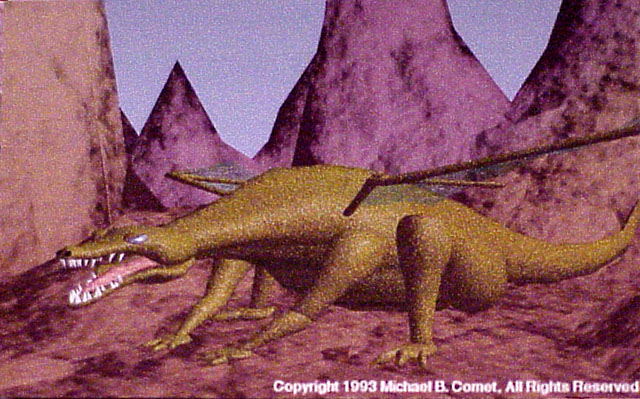
Spotlight Shapes Another spotlight test with basic shapes. This is probably an earlier render.

Bladerunner One of my favorite Ray Traces... though I can't take full credit. Not only is the image based off of the movie, but mine was actually a copy of another 3D artists rendering that I found in the gallery of a Lightwave magazine. I would look at other artists work and try to copy to learn how to create my own work in Imagine.
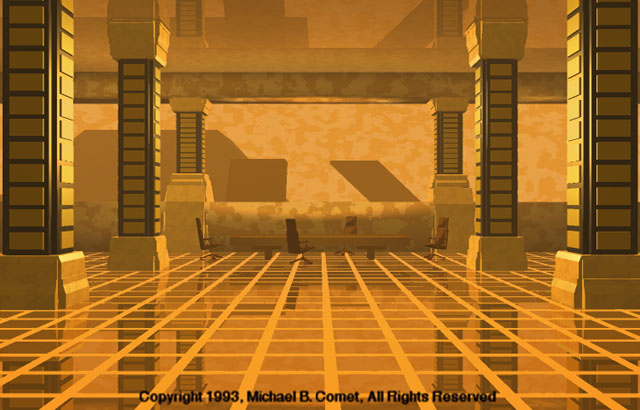
Cable Truck Another 'study' image based off of a model from another 3D artist featured in the old LW magazine...someone who eventually was working at Will Vinton, though I forgot his name. The purpose of this again was because when I saw his image I was like 'Wow! Can I do that?'. So I looked at it and broke it down, and tried.

Amiga Computer - 1992 A rendering and model I did of my old Amiga 3000. This was created on the Amiga back in probably 1992. I mapped each key with a separate letter imagemap, which at that time seemed pretty cool, and intensive.
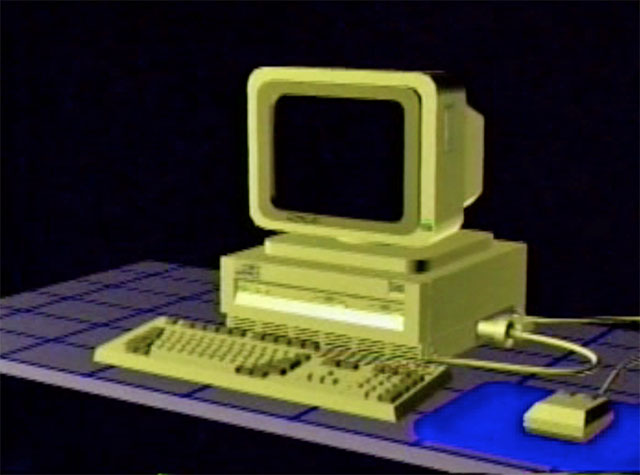

Amiga Computer Room - 1992 Another angle of my Amiga 3000 I modeled and textured using Imagine 3D.
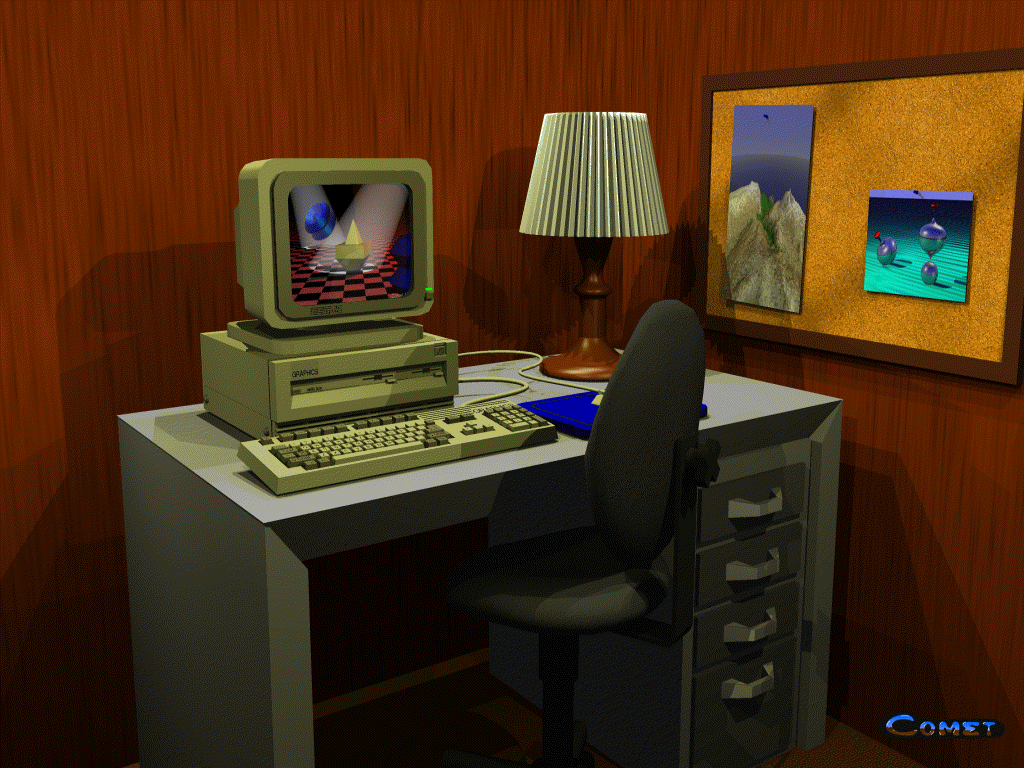
Amiga Computer Flying - 1992 A fun image of my Amiga flying next to colored chrome spheres. This was inspired by a similar layout from a print ad I think I saw somewhere.

MetaBlob - 1993 Playing around with some Metaball features and shading around 1993 or so.
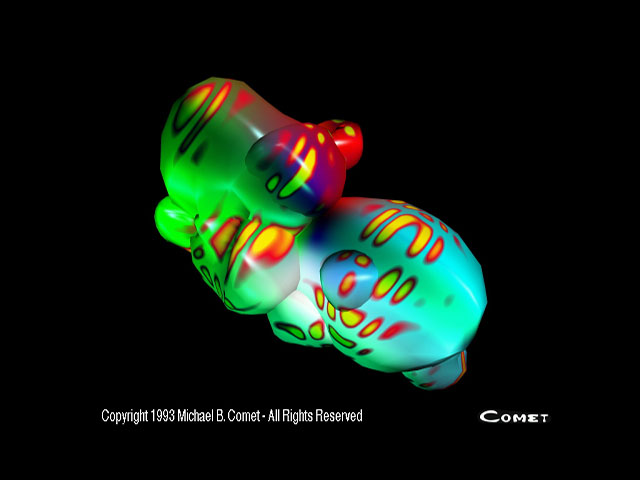
Space Game Logo Image One of the games I started writing "Space Game" this was the company logo image.
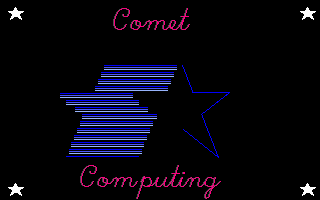
Space Game Title Image The title screen and my crappy 3D graphics for the Space Game.
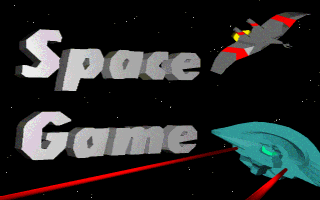
Space Game UI and Credits Three images, one the User Interface I was working on and two of the credit pages.

Psychotic Overload - 1993 Another image for another type of digital magazine my brother and I were trying to do called Psychotic Overload.
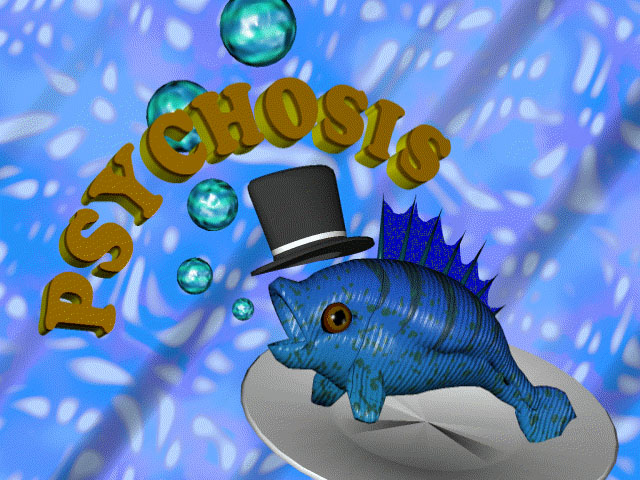
Space Fighter - 1993 Inspired around 1993 by Babylon 5 and some of the Lightwave work by 3D artists at that time, I tried creating some of my own spaceships. My modeling skills were still pretty bad, as were some of my texturing ability, so this is what I did.
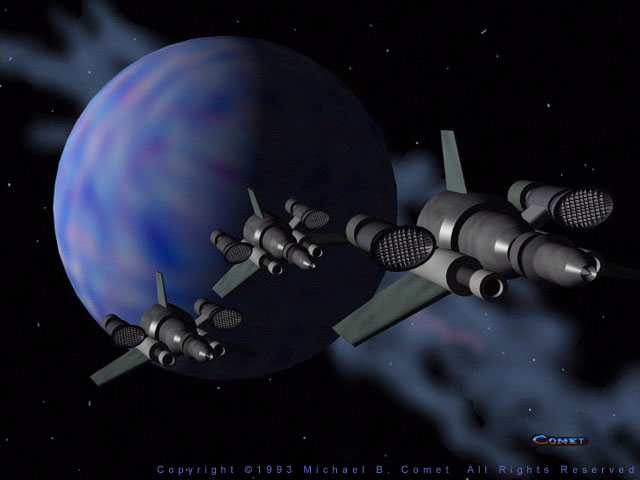
Space Ship 24 Bit - 1993 One of the first higher resolution 24 bit images I did. Again inspired by Babylon 5. I ended up recording a small camera move around the ship and it flying. At the time you couldn't play back images at that quality in realtime. So I used our S-VHS decks and toaster to do "single frame recording" onto VHS. That means showing a single image, and telling the tape deck to rewind 5 seconds, play, and then drop a single recorded frame at the end. Then manually load the next image and repeat the tape deck procedure. Very time consuming to lay down even a single second of footage. I did this and just a few others in that way. Eventually a new device for my Amiga 3000 called a "Personal Animation Recorder" or PAR Board came out which allowed 720x480 24 bit images to be streamed in realtime using their hardware card a few years later.
Each of the windows on the ship was a separate polygon hand placed.

Ethernet Card - 1994 This was part of an animation I did for fun when I was working as a software engineer at Case Western Reserve University's network department. The card basically flew around and a laser shot out which then caused the logo for the school to appear.

Ethernet Box - 1994 This is another rendering of the card, and the faceplate that was on the wall of all of the schools dorms to allow the card to be plugged in. Created with Imagine PC 3.0. By this point my modeling of more engineered type shapes had improved significantly.

Sci-Fi Hall While I was working at CWRU doing network programing, I ran into some people in another department who were working to create a SciFi CDROM magazine with Director. I think it was Director 3 or 4 at that time. After talking to them, we decided I would be able to help out by creating all the artwork for the interface for the magazine.

Sci-Fi Hall 2 This is a more complete version of the train hall from a different angle. I never did end up modeling the train in it.
Sci-Fi Diner Closeup of a dining area I did for the SciFi CDROM magazine. The red screen in the background was related to an original interface I had designed, that the CD was supposed to use. The idea being that there would be hotspots that would take you to the interface to get to the real content of the magazine. Kind of like "Myst".
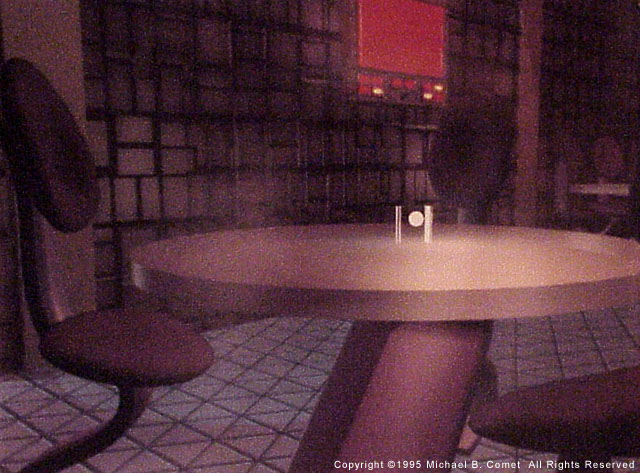
Sci-Fi Composite These are some more shots of the diner area. All of this was created with Imagine and the PC version of the software. If I recall, this was actually one of the first projects where I switched to the PC version. With the train hall being modeled originally on the Amiga, and then transferred and finished on the PC side.
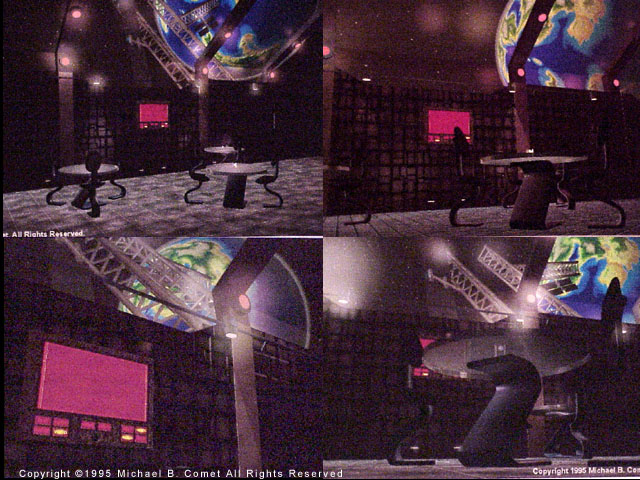
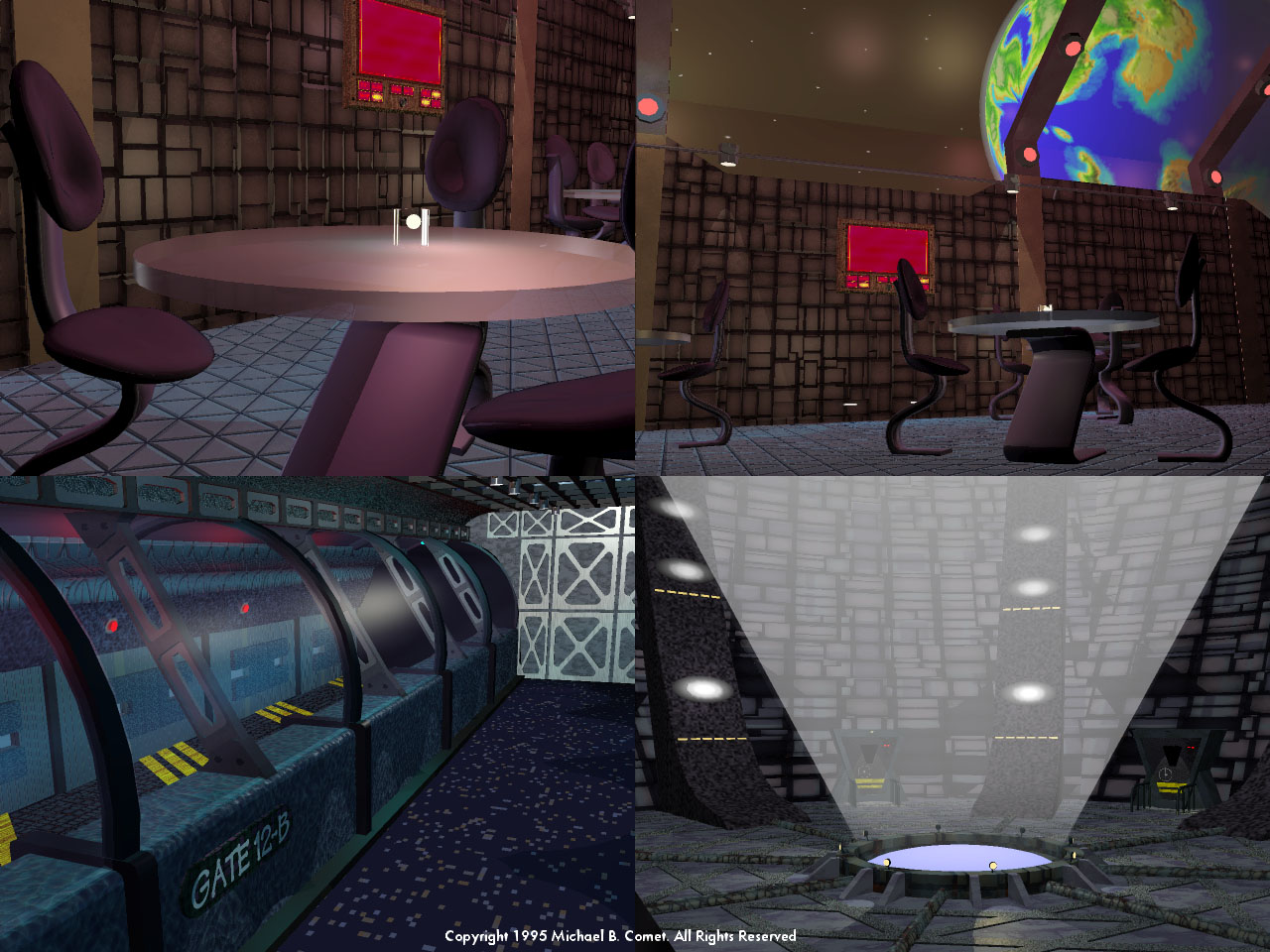
Sci-Fi Menu This was part of the main interface for the magazine. Text for each article was actually placed in the light beam, and was used to control what you picked. Most of the textures relied on the Essence Textures by Steve Worley again. For example the paneling on the background was all done procedurally.
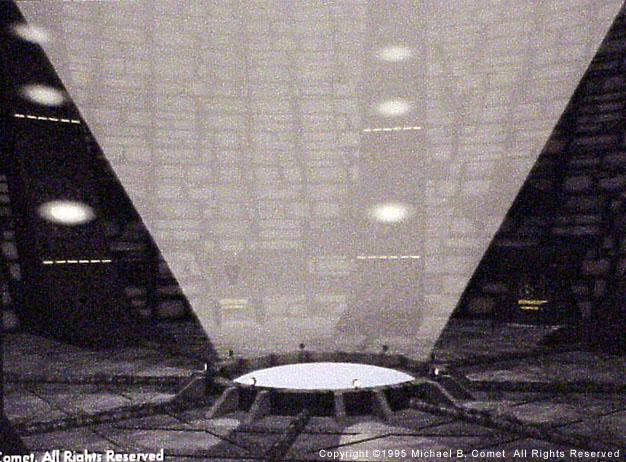
Fred This was a character I modeled for Doug Kelly to do his short with. It was also used in his Lightwave 3D 5 Character Animation book. It was created mostly in Lightwave 4.0 PC. Even then, my organic modeling wasn't too perfect. You didn't have anything like Meshsmooth/Metanurbs/Subdivision Surfaces at that time.

Tunnel - 1994 Almost as bad as chrome spheres, animated tunnels are another "no-no" nowadays in CG animation. This one though actually garnered interest from Blue Sky back when I applied in 1995. I guess they liked the specular mapping and lighting, though most of the textures were done with basic procedural Essence tile textures.
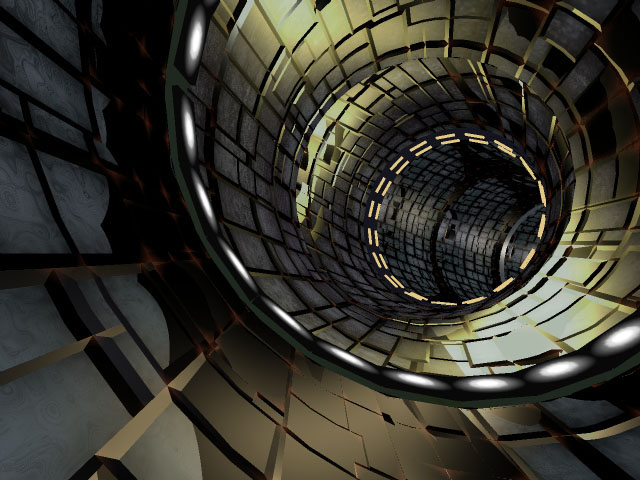
Comet Graphics Logo An animated logo around 1995 or so I made inspired by one I saw on TV.
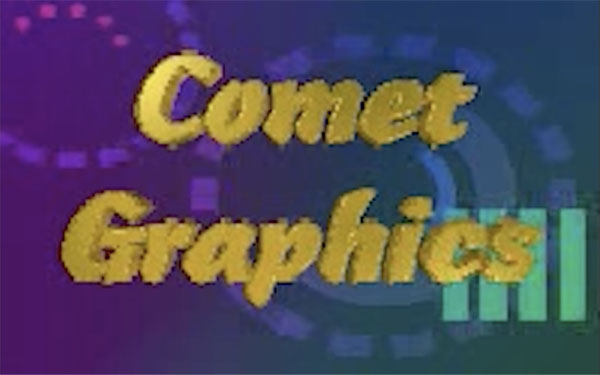
Temple - 1995 Another version of the Temple scene around 1995 again for trying out new software and techniques.
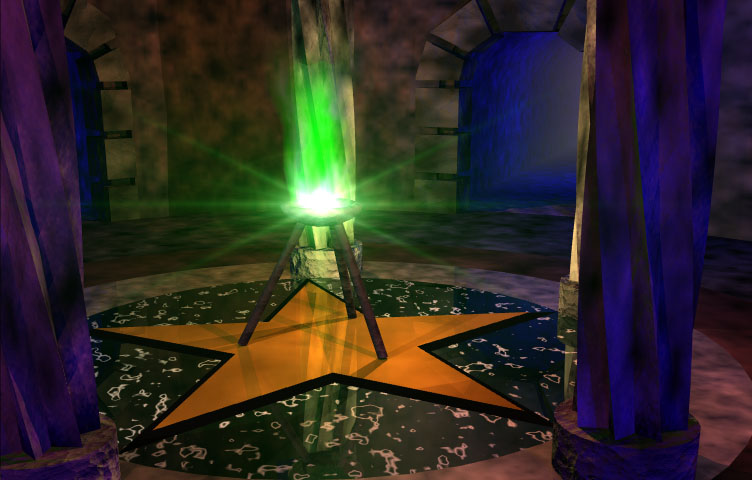
Fog Tests I believe this was me testing Fog in Lightwave which at the time was a new feature / development for 3D software.

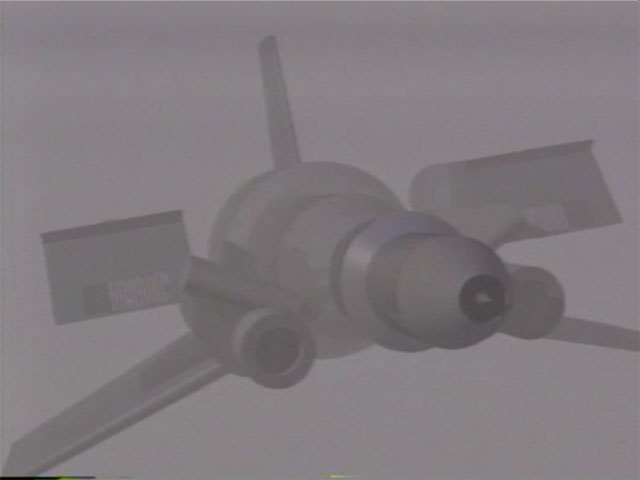
Mike Head 1 After doing a simple head for the Fred model above, I decided to try to figure out how to do a more realistic type model in Lightwave 4.0. I ended up finding the only way, was pretty much to take a basic model and deform it, or weld points etc... There weren't really any "cutting or slicing" type tools back then. This is from 1995-1996.

Mike Head 2 This model was basically started (and never finished) by taking primitve flat square/plane objects, and welding them together, and then deforming each individual point by hand to get the shape. I would take what I had, add another basic plane object, with 8-10 sections, and weld the parts together, and then keep moving points.
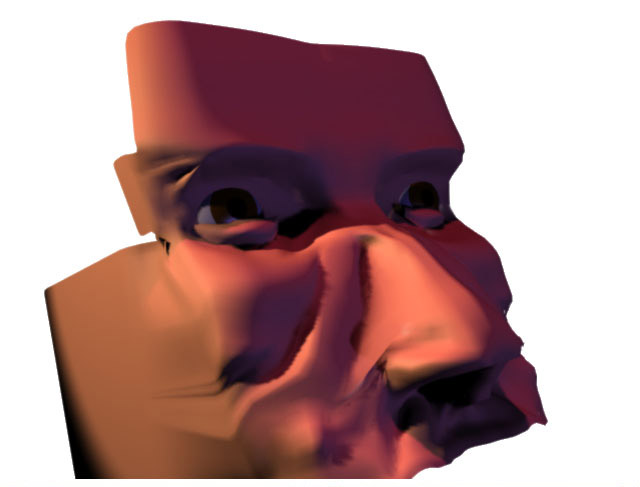
Mutant - 1995 This was a character I created in 1995 with Lightwave 4.0 for a PC video game called "Vicious Circle". It was a freelance job I did from home, which I never got paid for, since the game never got published. I knew that might happen, but decided to help out since it gave me a bit of experience. I actually ended up animating a number of actions and making sprites as well as cinematics.
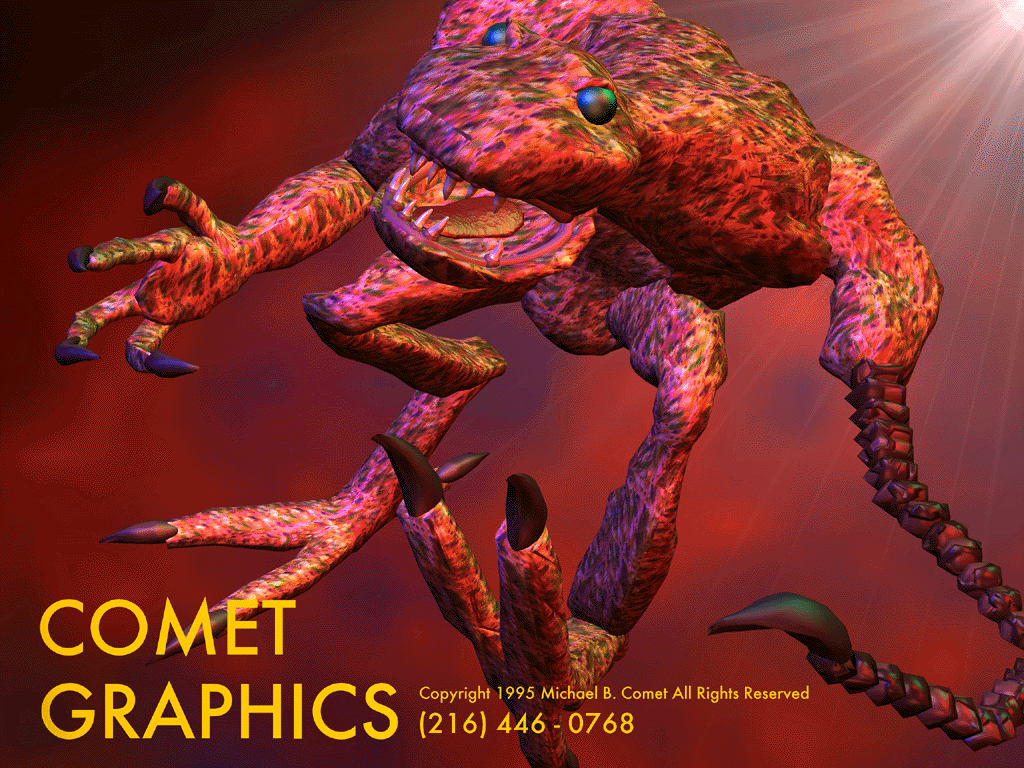
Cyborg Cinematic - 1996 I did a freelance job creating a cyborg and a mutant character for a video game called "Vicious Circle". The work was basically done for free with hopes of eventually getting money. It involved design, model, rig and shading of the characters for sprite animations as well as some high res cinematic cut scene work. This is from the cyborg getting assembled.
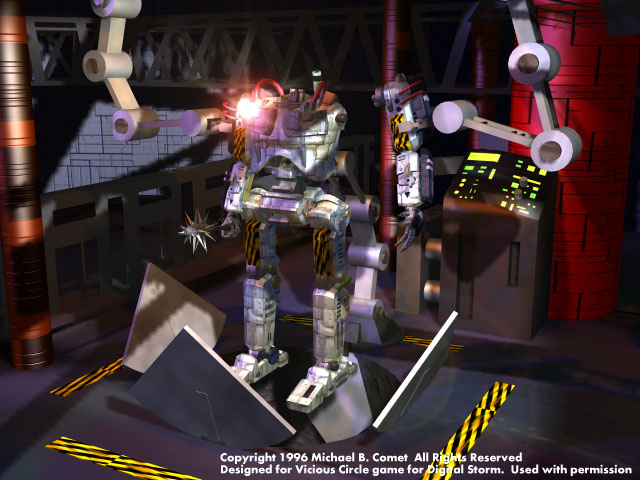
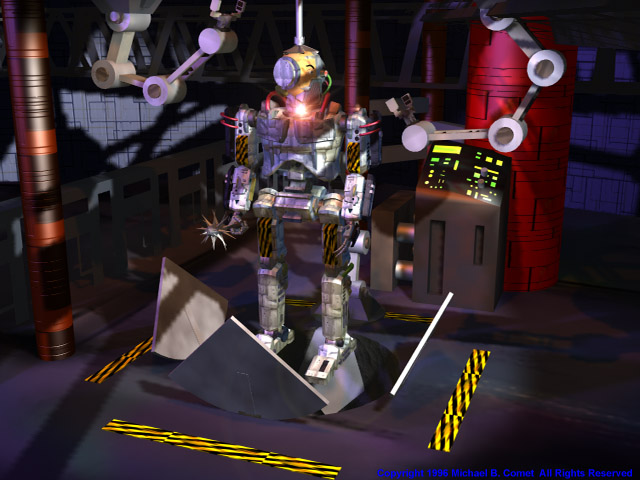

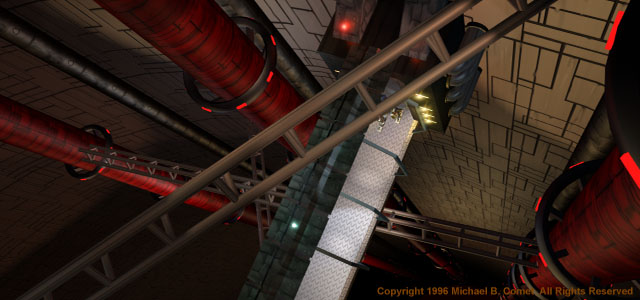
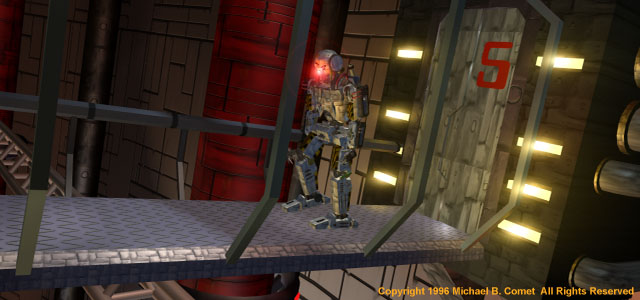
Temple 1996 This is a temple image I did. I found the response I did in the first version with Imagine so strong, I recreated it in each program I learned after that, including Lightwave 4, and 3D Studio MAX r1.2. Because it's very simple, it was a good way for me to learn the basics of the program.

Programming in my Bedroom Here's a picture of me probably mid 90's programming in my bedroom.

Here is a higher resolution image from another day. Books in the back include a "PC Interrupts" reference and a
"Programming Windows 3.1" book, some boxes of early Quicken software, and a Sound Blaster box. There appears
to be an Amiga magazine on top of the covered laser printer, old phone, and of course amazing large 90's style shirt.

Spline Coding 1994 This is an example of a Spline image program I created as part of my final Computer Graphics class for college in 1994. Written for Windows for Workgroups the user can click to generate points and then the points were connected with either Catmull-Rom curves or Cubic B-Spline. Here showing Catmull Rom.
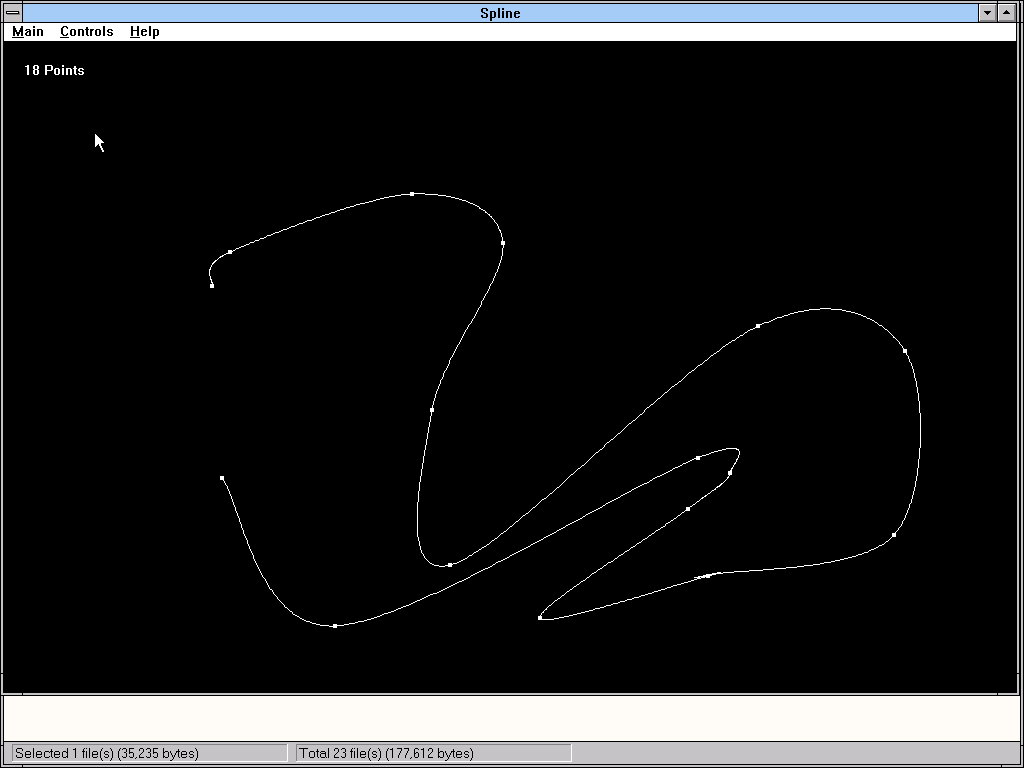
Spline Coding 1994 B Spline Changing the type of curve to closed and B-Spline. In addition I had an overall tension control that could be adjusted as well as shown in the menu.
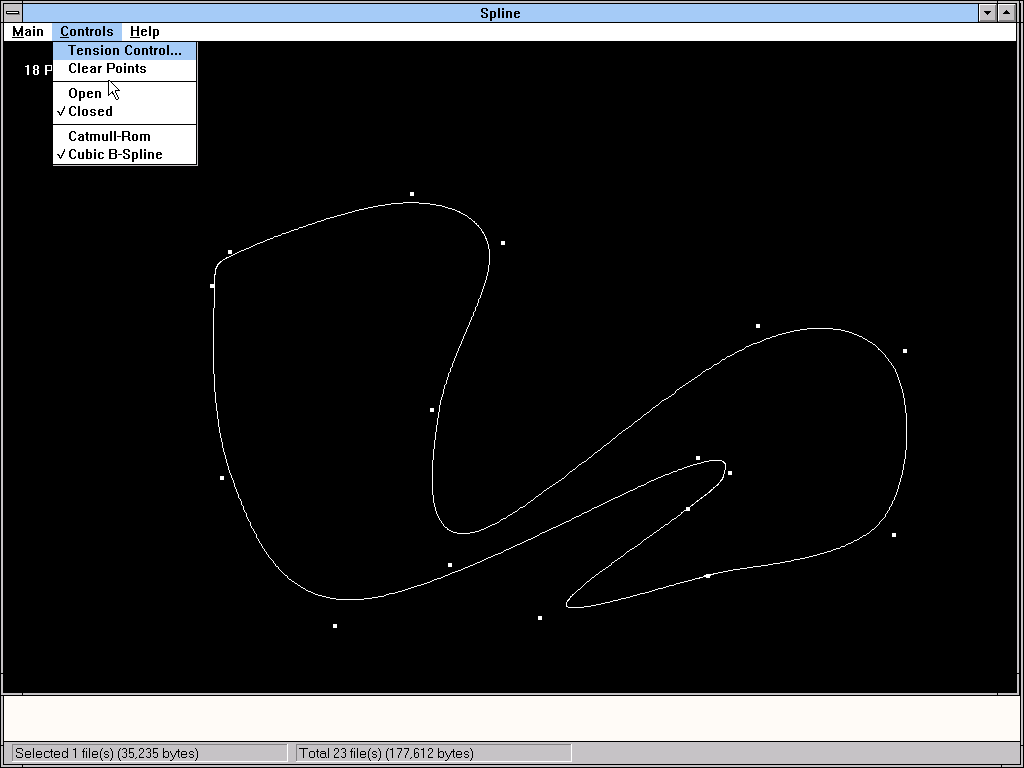
Fusion 3D 1994 The larger project I coded for my final in the computer graphics course was writing a full fledged modeler and scanline renderer. While fairly basic it allowed multiple viewport windows, depth sort rendering, and z-buffer scanline rendering.

Fusion 3D 1994 - Wine Glass Modeling This image shows the modeling part of my program. I didn't have much experience so I copied much of the workflow from Imagine 3D. This meant you were required to generate a transform/pivot for an object, then separately draw down points, then after points were creted manually connect edges. Then finally create faces. Notice here how the bottom of the glass is still just points compared to the next image.
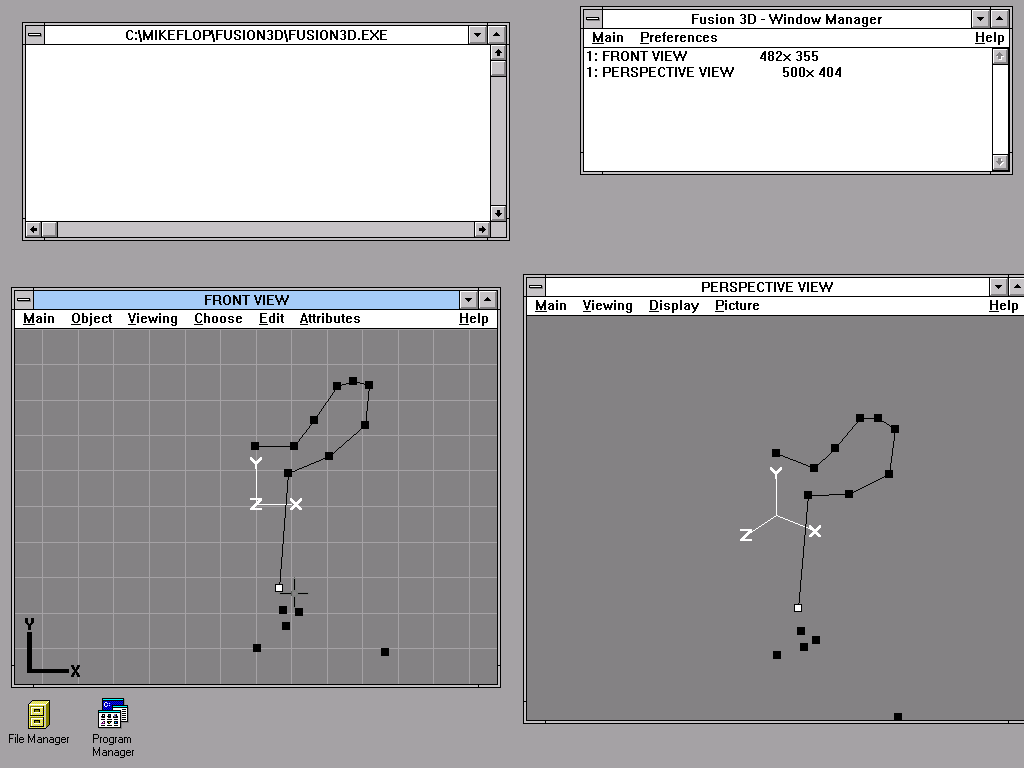
Fusion 3D 1994 - Wine Glass Modeling Here the modeling on the glass is continued by manually clicking on points to create edge connectivity. I then implemented an extrude and a spin feature as shown in the menu.
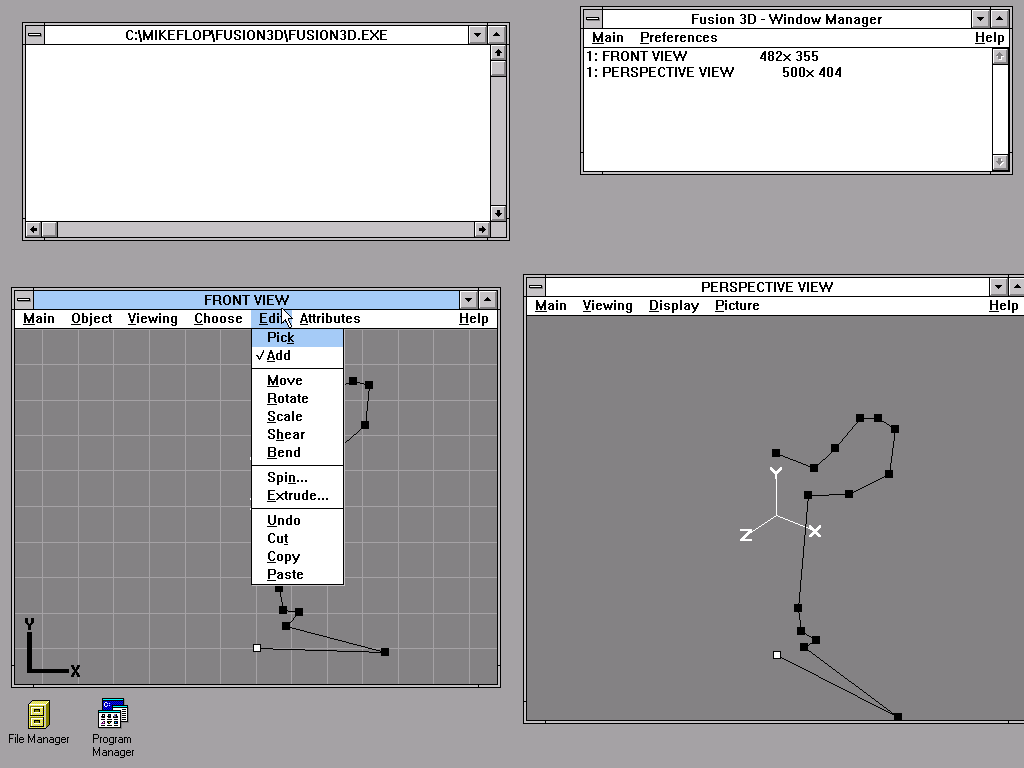
Fusion 3D 1994 - Wine Glass Wireframe The previous model now spun to create faces and a final 3D object in my final project I coded in C for Windows for Workgroups.
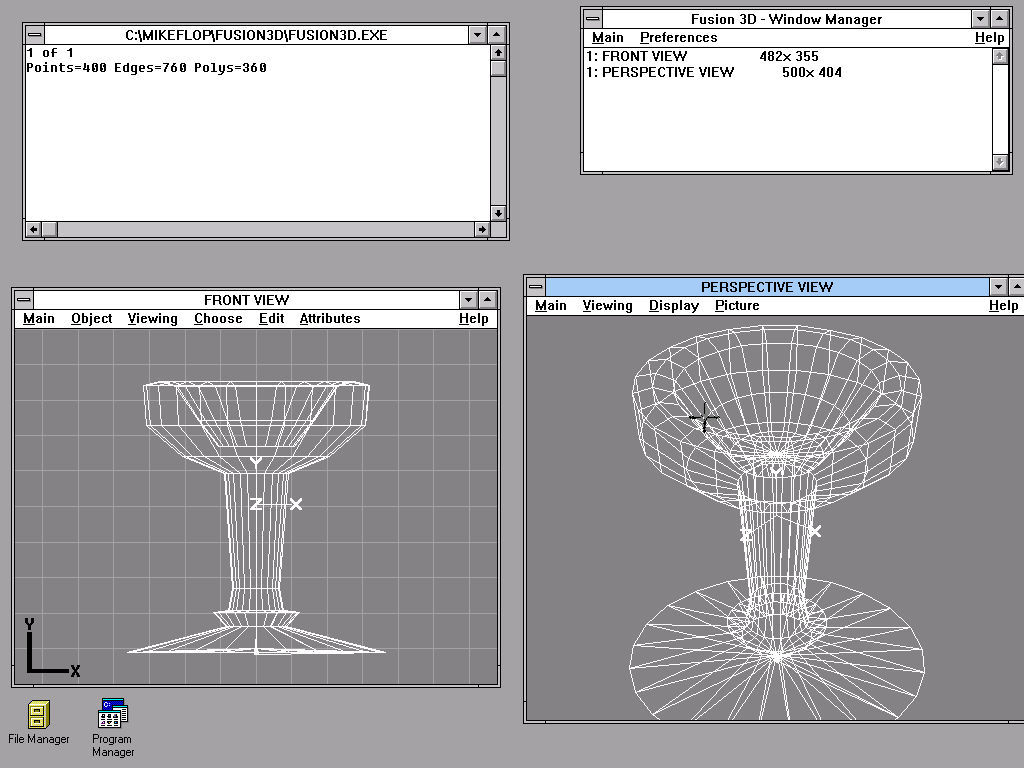
Fusion 3D 1994 - Wine Glass Solid Displaying my glass using depth sorting from camera for each face to get hidden line removal. While I had coded early line clipping as part of the class this was a lot quicker to implement given everything else I had written for this program.
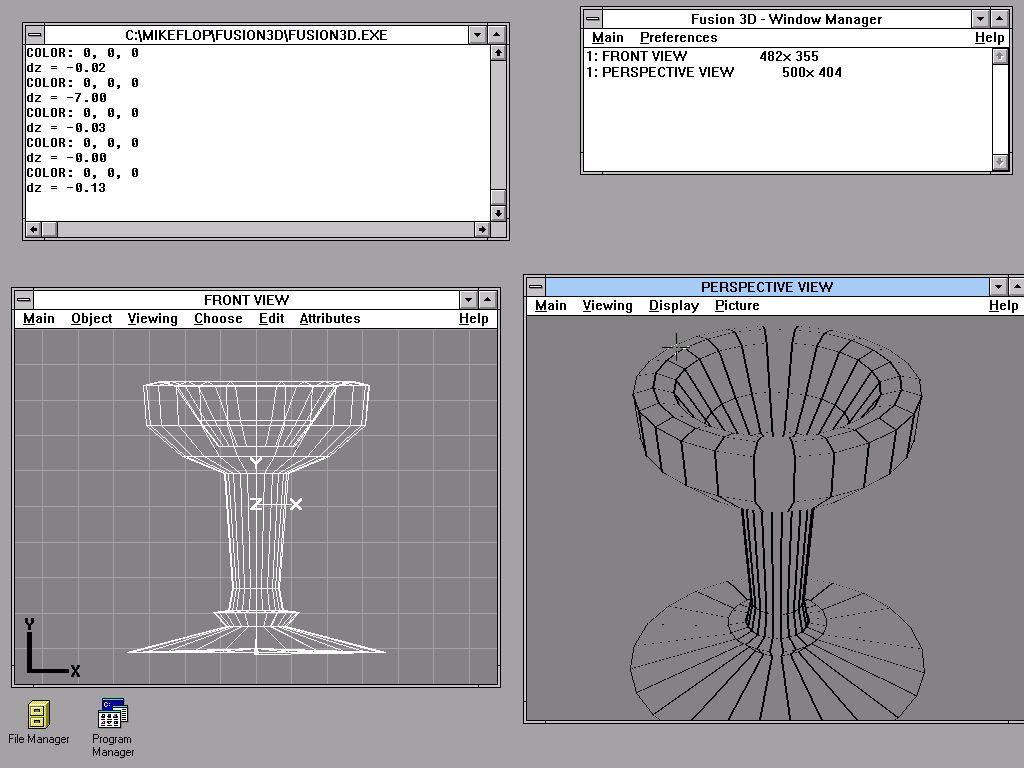
Fusion 3D 1994 - Wine Glass Render Sample render of my wine glass using ZBuffer and Flat shading. My program eventually supported basic Phong shading.
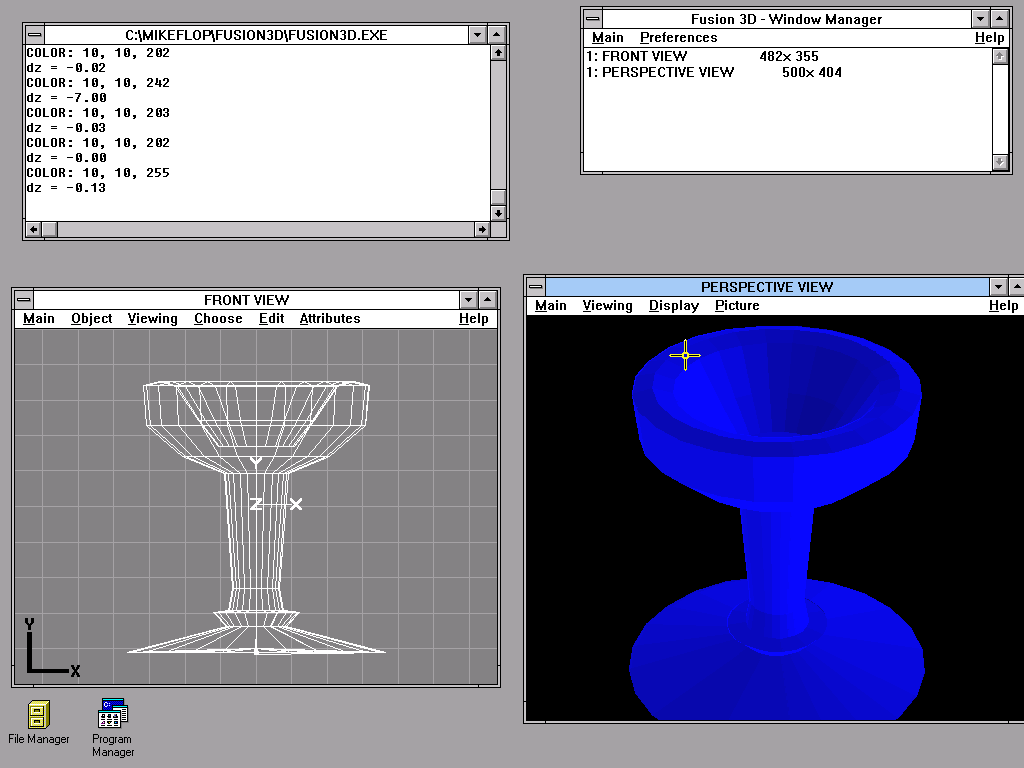
Spectrum 3D 1995 - Sample After finishing my 3D Project I decided I should clean up my code, make it more robust and work on more features... The original idea was to make this fully functional as my main 3D application and maybe eventually use and sell. I never got quite that far but did clean up code and allowed for better colors and Phong shading in as shown here.

Spectrum 3D 1995 - Torus Another image of my 3D modeling and rendering program renamed to Spectrum 3D showing a basic torus.

Case Western Reserve University - Banners Back around 1995 or 1996 Case where I went to school and was working as a network engineer started the very first web page (right after getting Gopher working which was effectively a text only based web sort of thing). I ended up making early header images for each of the main webpages using Lightwave 3D. While working for the network software engineering department I helped maintain "Freenet" which was an old dial up modem text interface for the school, as well as wrote a Winsock implementation for Windows to sit on top of our TCP/IP protocols. And also was a part of setting up Gopher and then the first HTML Web Servers.
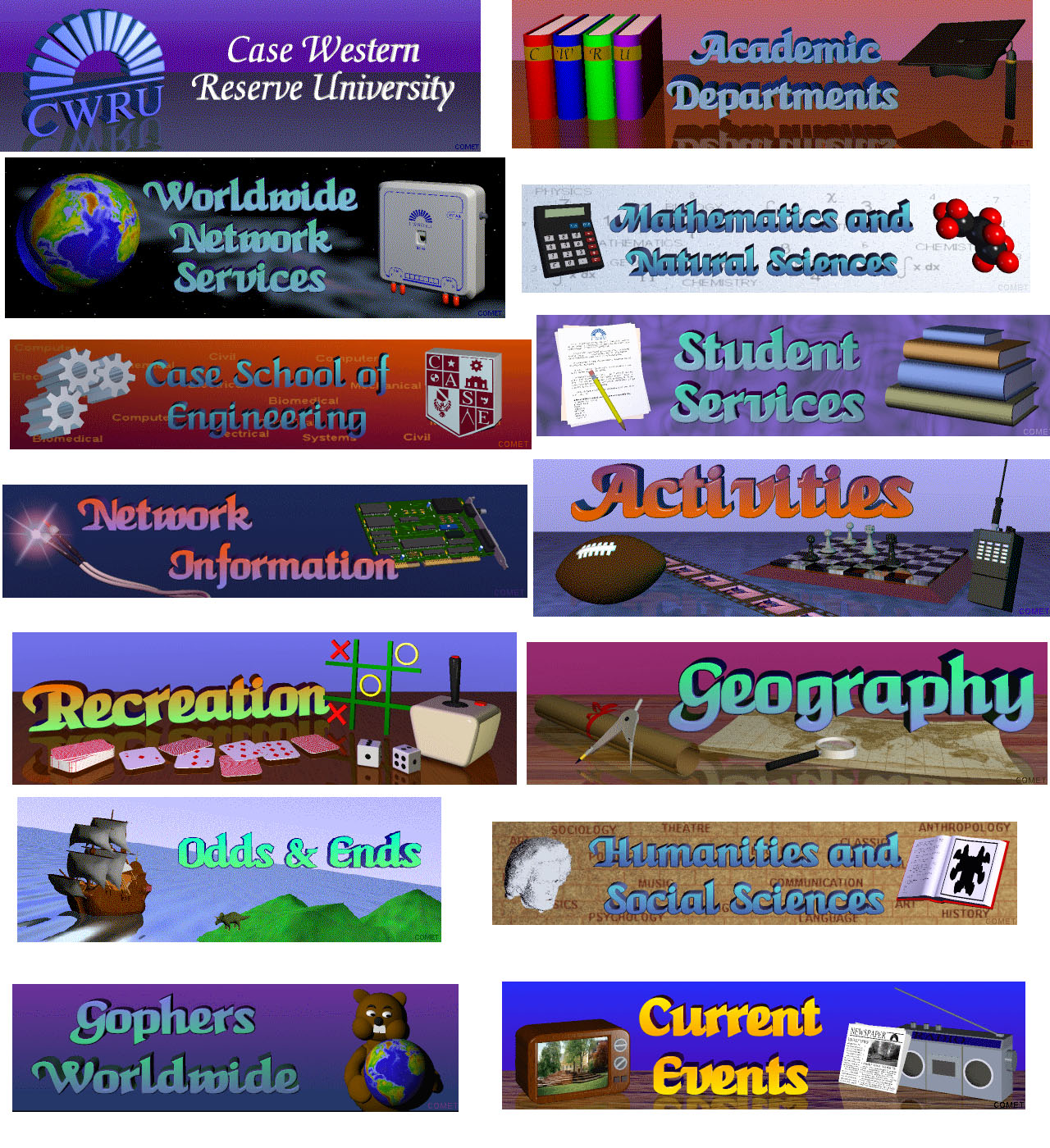
CWRU Film Society Logo - 1996 Again around 1995 or 1996 at Case where I attended college and then started working in the network department a friend and coworker was running our film society group. I created a logo and helped them with flyers and posters at the time using Lightwave 3D.

Lightwave Procedural Shading - 1996 Back in 1996 I started writing my own shaders for Lightwave. This was based on information from the famous procedural "Texturing & Modeling" book by Ebert, Musgrave, Peachey, Perlin and Worley. My code was super slow but functional. When I heard that Steve Worley was going to release his own plugin for shading I aborted. Sadly he never released so I clearly should have finished, sold it and learned / started a business. Oh well. Still this was maybe the first ever "plugin" coding I ever did.

Buzzed Beer - 1997 I landed my first computer graphics job working at Volition Inc. on Descent Freespace and Summoner as an animator. In my free time I worked on a small short film with a fly and a frog. For fun I put this unrelated image together with my fly model.
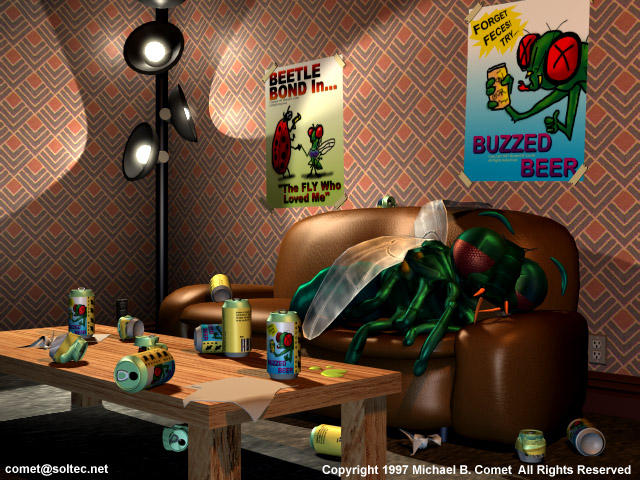
Fly - 1997 The fly asset for my short I modeled, shaded, rigged and animated.
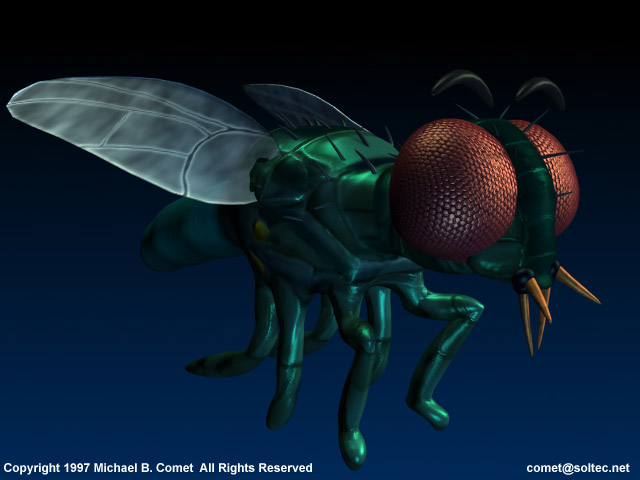
Frog - 1997 The frog asset for my short I modeled, shaded, rigged and animated in a funny pose for my old website.
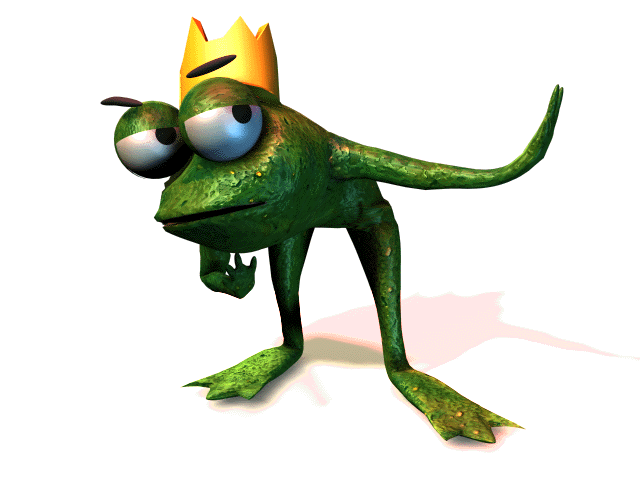
Frog Short - 1997 Shot of the frog in my actual short film.
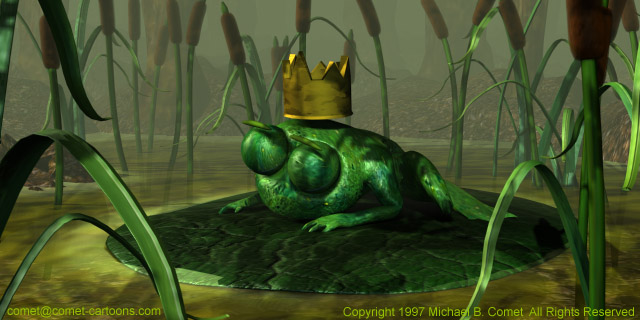
Home bedroom 1995 I'll end with some shots of my bedroom circa 1995 in my parents old house. This was where I coded all the AnimaPaint program, games, and other stuff as well as worked on most of the graphics above until the late 90s.
Notable items include:
- The i386 or i486 desktop on the left from Gateway Computers I believe
- Extra video monitor for graphics viewing
- Both a dot matrix printer on the bottom left for color prints and Laser printer on right stand for text
- 3.5" Floppy disks on printer stand and storage for more on top right of desk
- Lamborghini Countach picture on wall
- ED-209 vinyl model on the reverse angle shot, I believe a milenium falcon is next to it
- Robocop model on the bed headboard behind plastic skull and christmas hat
- Stuffed Penguin "Opus" from the Bloom County comic strip
- Covered on the left Ensoniq EPS (performance sampler) keyboard and audio mixing board.
- Mary Stuart-Masterson photos because "Some Kind of Wonderful" movie
- Oh and I believe that was a water bed... because 80s/90s
Note these images are larger but are scaled inline here. You can right click to open on a new Tab to see a larger version.


Thank you for sharing some 80's and 90's time period and early computer graphics nostalgia with me!
